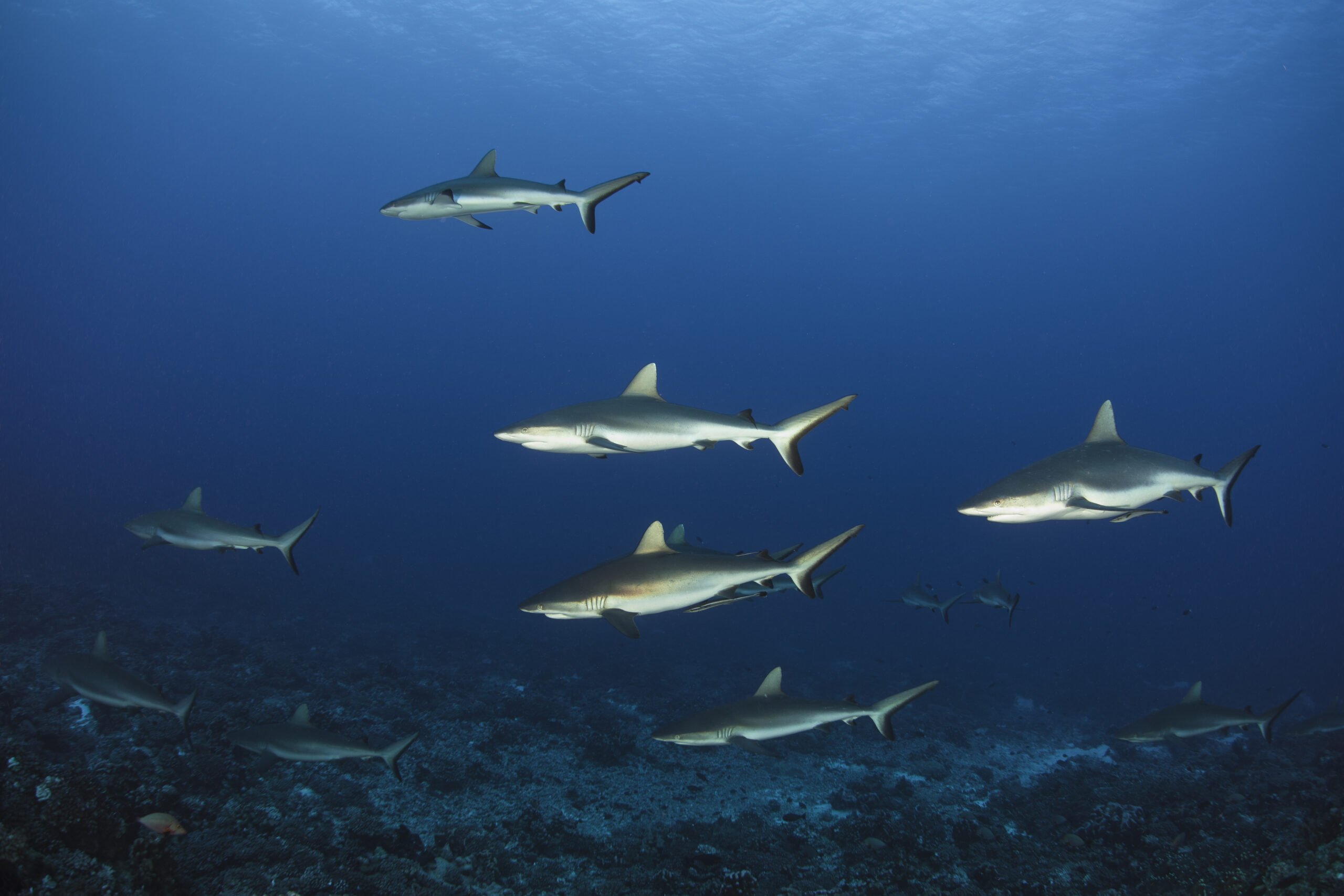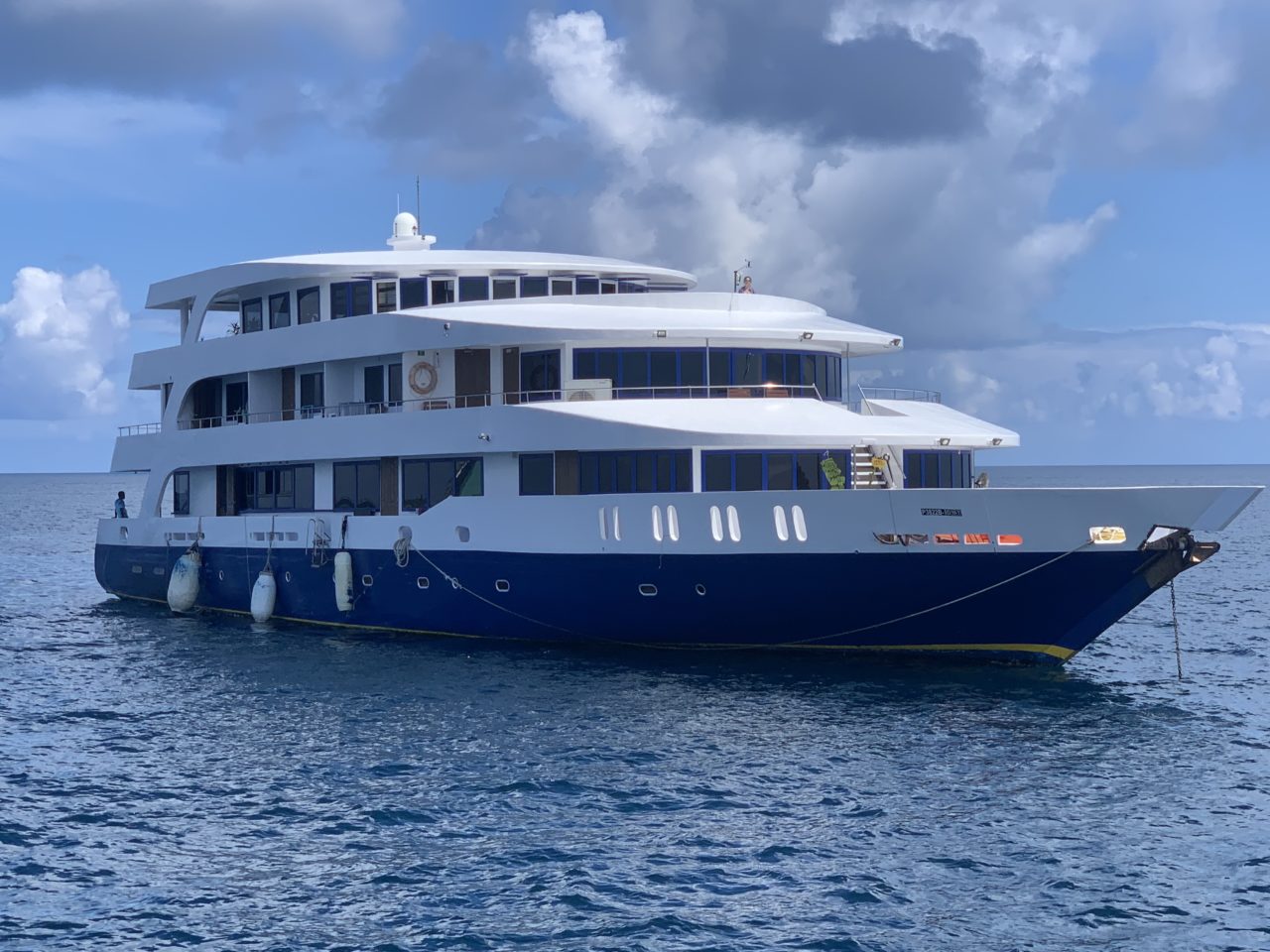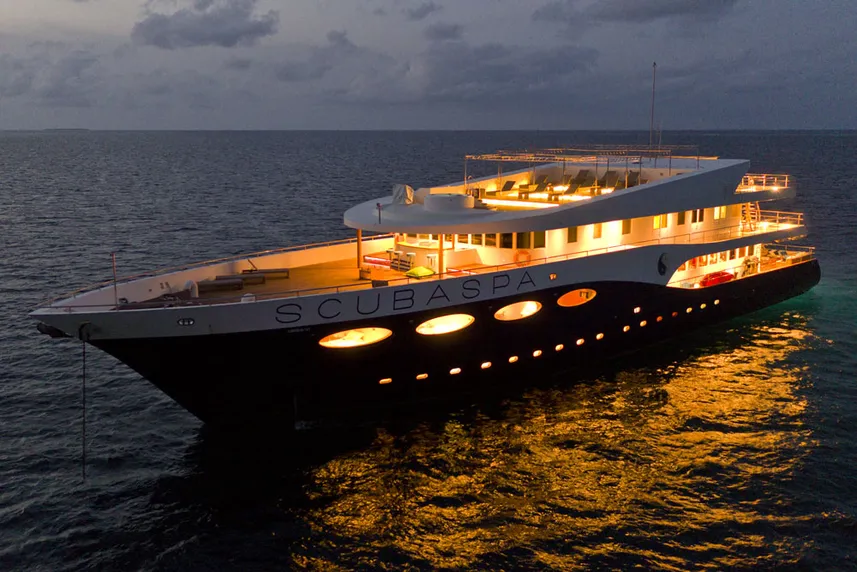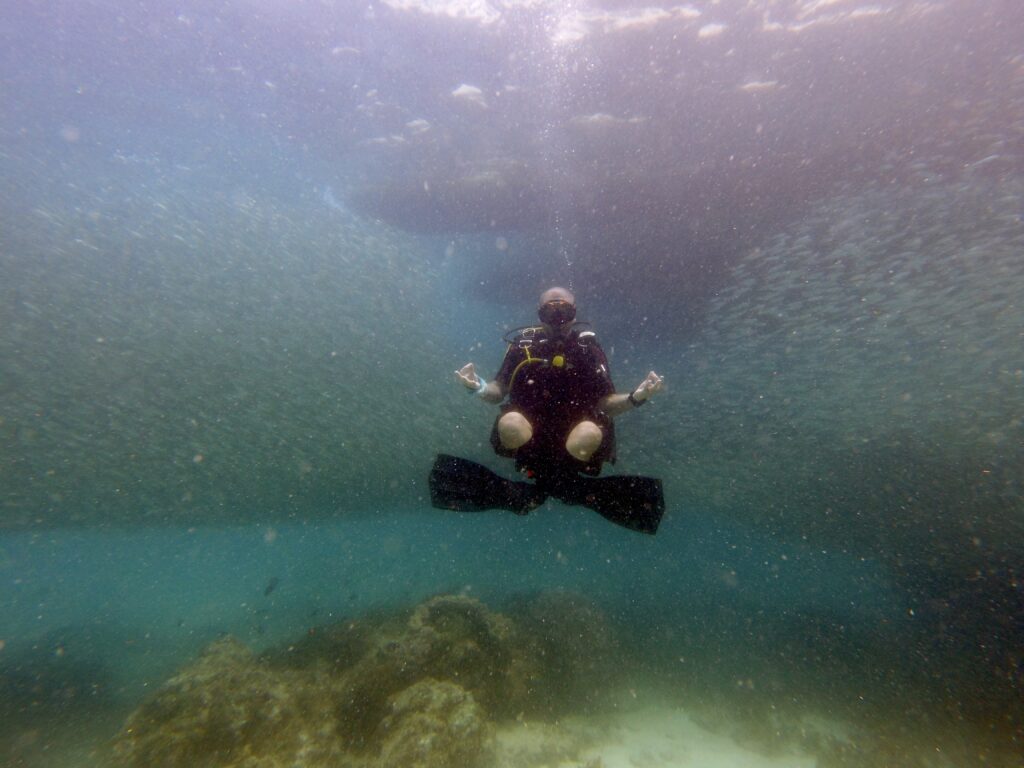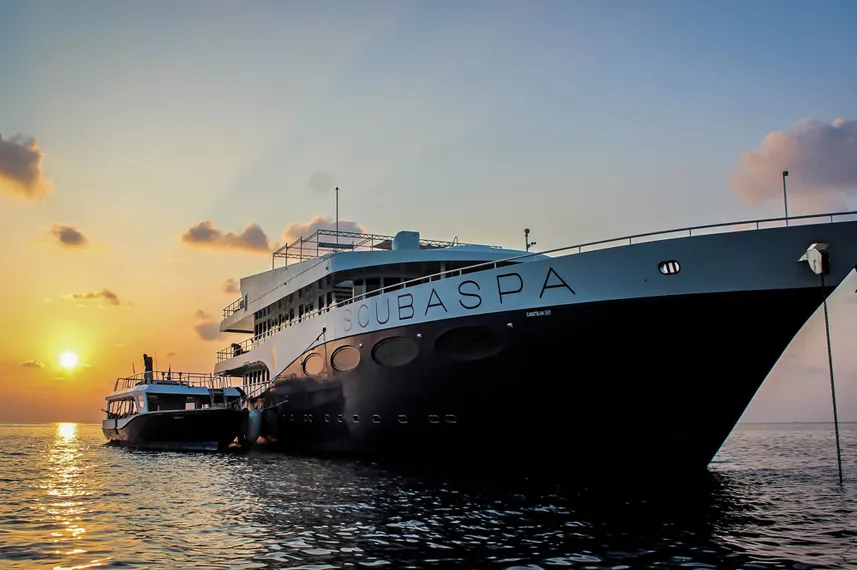
Located in the Indian Ocean, the Maldives is an island nation consisting of 1200 tiny islands grouped into 26 coral atolls. These atolls span an area of 90,000 km squared of which 99.6% is ocean.
Maldives diving is best known for big marine animals. All manner of shark species including Grey Reef, Whitetip, Blacktip, Nurse, Tiger, Thresher and Hammerhead Sharks are frequently seen!
The Maldives is also a superb place for rays – you’re practically guaranteed to see multiple manta rays together at feeding stations whilst diving the Maldives – both by day and night!
Here’s one such encounter I had on my last Maldives liveaboard:
On many Maldives liveaboards, one can expect other incredible experiences such as diving with countless Nurse Sharks at night, seeing hundreds of Grey Reef Sharks together and being immersed by scores of stingrays and reef fish during feeding frenzies.
I could go on and on about the many perks of diving the Maldives – and I shall later in this article, but first let’s start with the most important info!

In this article; I’ve reviewed the best Maldives liveaboards available in 2025 with stat breakdowns and price comparisons.
There’s also handy tips such as what to expect when going on a Maldives liveaboard, recommended packing lists and extra info like how to get to the Maldives, how dive conditions change throughout the year and so on!
Plus you can read in-depth (pun intended!) reviews of liveaboards I and other Diving Squad members have personally been on.
Rest assured, we’ve reviewed liveaboards across the full price range from cheap to expensive as well as everything in between!
So without further adieu let’s take a look at the Best Maldives Liveaboards of 2025!
Reviews:
1) TOP PICK: ScubaSpa Yang (Super Luxurious!)
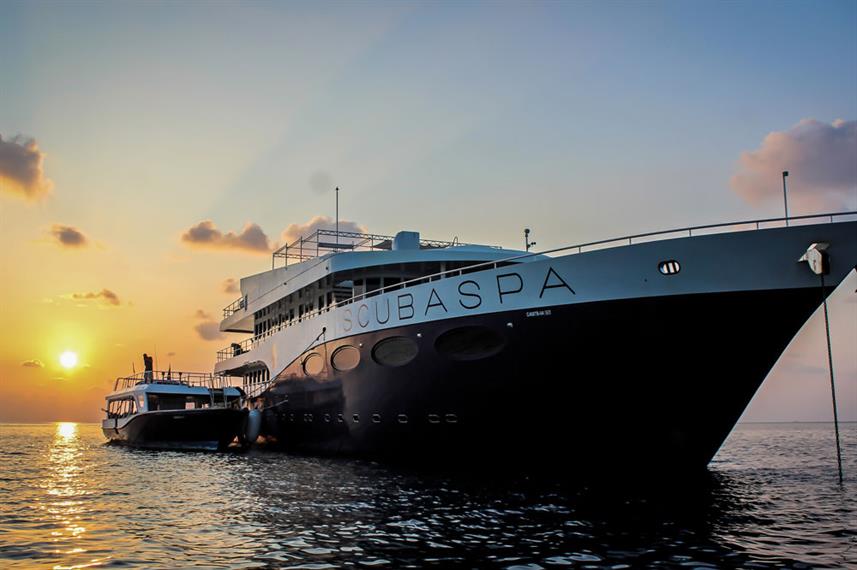
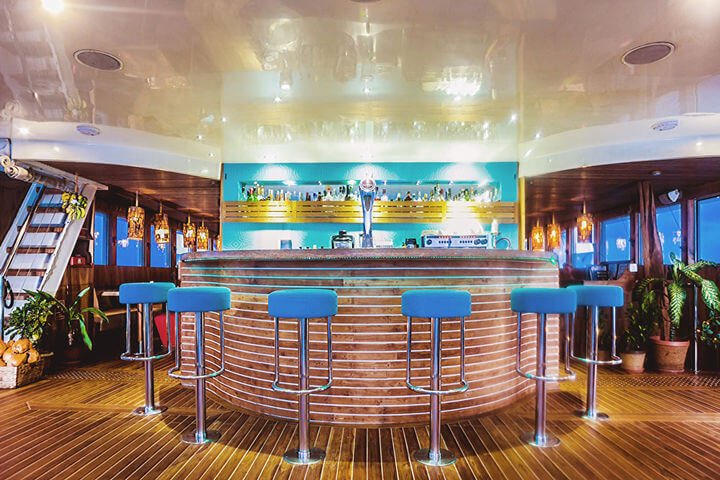
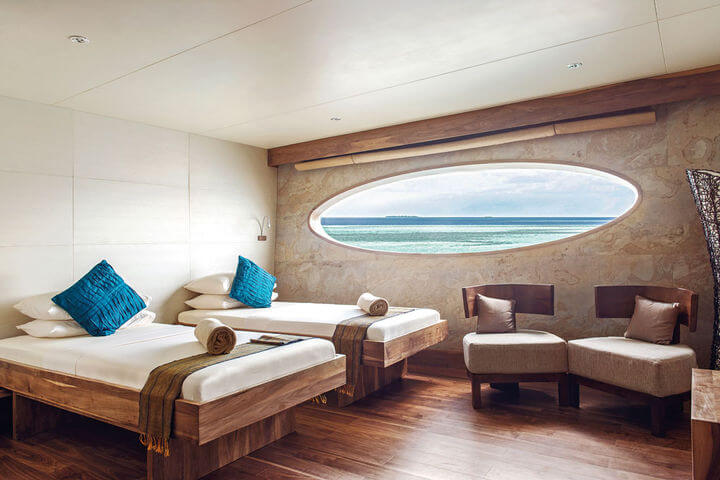
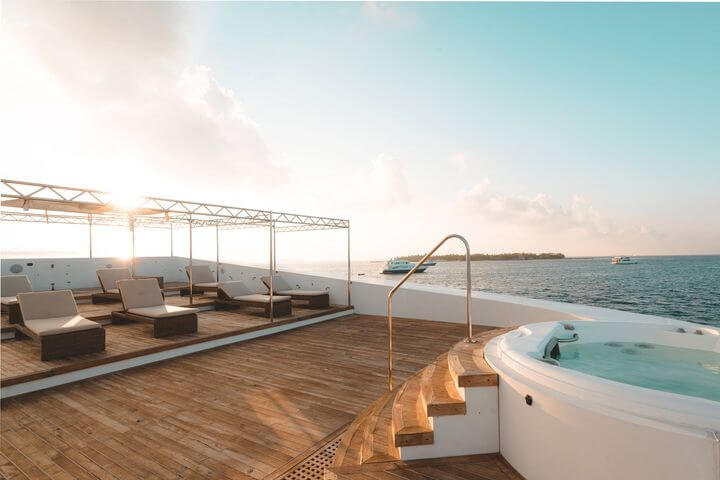
- Price: $$$ (Luxury Class)
- Central Atolls
- 4 – 7 Night Trips
- Spa, Yoga, Cinema, Jacuzzi, Gym
Scubaspa Yang is the most popular luxury liveaboard in all of the Maldives; with over 200 reviews and an average rating of 9.6 out of 10 on LiveAboard!
It may be more expensive, but Scubaspa Yang is the only Maldives liveaboard to be classed as a 5-Star PADI dive resort. There are several facilities that are unique to it including an open-air cinema as well as a spa with 6 treatment rooms (including a double for couples). There is also a gym, a jacuzzi and yoga; found on a few but hardly any other Maldives liveaboards.
At 50 meters long, Scubaspa Yang is truly massive; this shows with the extremely spacious cabins which have very large and comfortable beds, heaps of storage space as well as big ensuite bathrooms.
ScubaSpa Yang explores the famous Central Atolls of the Maldives; which are good for manta rays and sharks as well as dolphins, turtles and some nice coral reefs. The dive guides are very experienced and will make your safety their top priority. There is a nearly 1:1 crew to guest ratio and all staff are extremely friendly and professional.
Other activities include kayaking, stand up paddle boarding, yoga classes, movie nights and beach barbecues.
2)Luxury Runner-Up: White Pearl
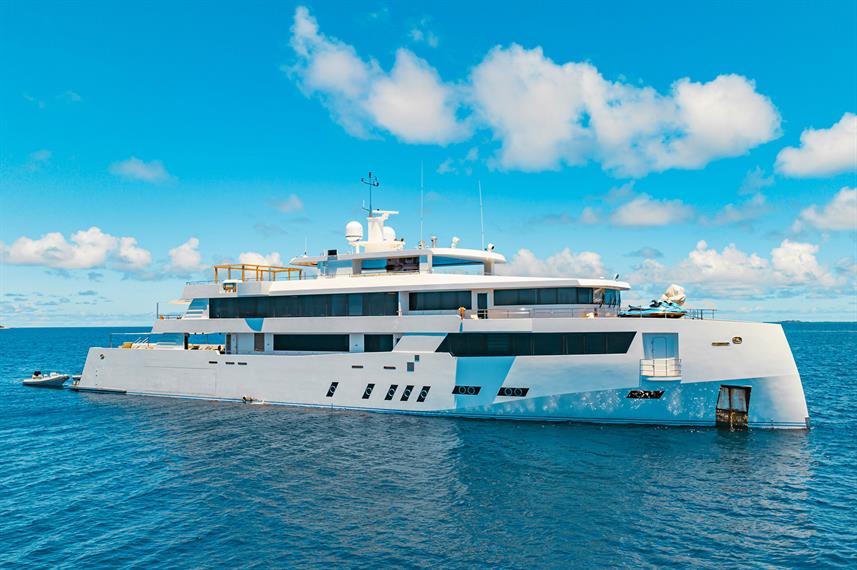
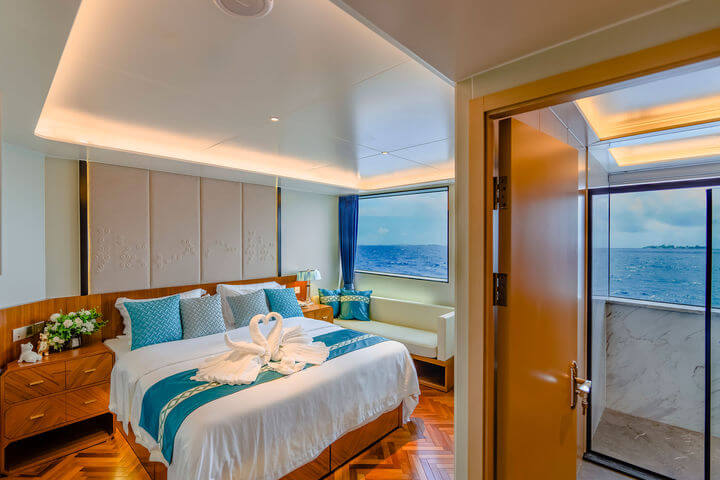
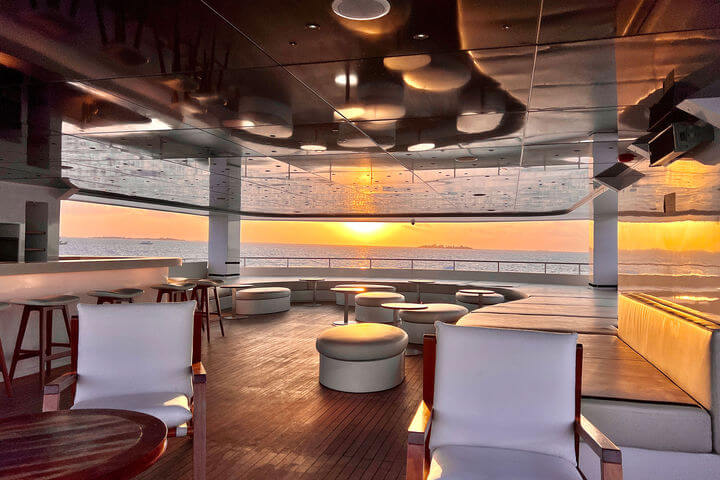
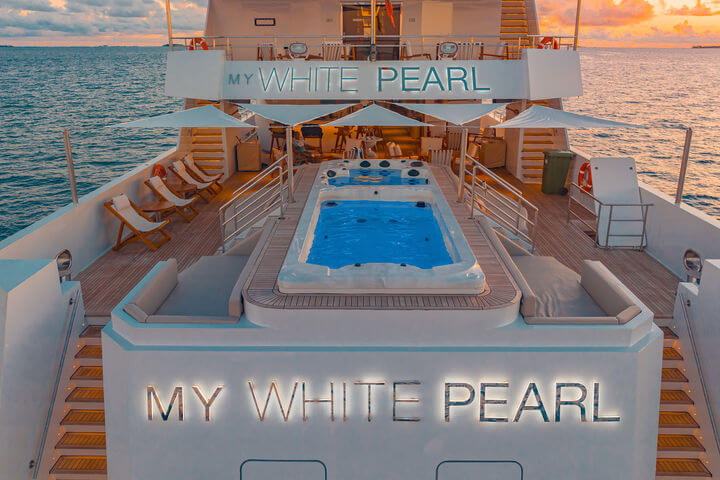
- Price: $$$ (Luxury Class)
- Central Atolls
- 5 – 10 Nights
- Swimming Pool, Games, Consoles, Business Centre
- Spa, Gym, Yoga, Jet Skis, Extra Beach BBQs
White Pearl is the only other liveaboard in the Maldives that can match up to ScubaSpa Yang. It is a 53 meter long superyacht with many unique and luxurious facilities.
For starters, White Pearl is the only Maldives liveaboard to have an onboard swimming pool (with jacuzzi attachment) as well as as an entertainment lounge with games consoles, public access computers and business centre!
The cabins are huge; all have HD Satellite TV’s and ensuite bathrooms and in the case of the larger Suites, there are also lounges, work desks and private balconies.
White Pearl explores the Central Maldives atolls which are great for seeing manta rays as well as many species of shark plus dolphins, turtles, big pelagic fish and countless reef fish over the coral coated pinnacles and ridges that forms a dramatic underwater landscape there.
Guests can enjoy many extra activities including visiting the atmospheric onboard spa, jet skis, kayaks, yoga lessons and not 1 (as is normally the case with other liveaboards but 2 beach bbqs! Staff are extremely friendly and competent – they will go out of their way to make your trip a truly memorable one. The dive guides are very professional – whilst the chefs are very talented.
Perhaps the only reason White Pearl is not yet as popular as ScubaSpa Yang is because it is much newer, having only been built in 2020. Despite this; it has just as many luxury facilities; is slightly larger – yet not as expensive as ScubaSpa.
3) My Favourite Maldives Liveaboard: Soleil 2
- Price: $ (Cheap)
- Central + South Atolls
- 7 – 11 Night Trips
- Private Terrace Cabins
- Jacuzzi, Beach BBQ, Traditional Music, Fly-Boarding
“Soleil 2 is the finest damn liveaboard to cruise the Maldives and also the only one to so far offer me a free trip in exchange for creating movies for them – which I happily did back in December 2023!
Despite having a luxurious feel with massive cabins (some featuring private balconies), a gorgeous indoor saloon with huge TV, rammed full of giant shark teddies plus an awesome outdoor lounge and sundeck with copious amounts of plants, hammocks, beanbags and a hot tub; Soleil 2 is actually one of the cheapest liveaboards in the Maldives!
The owner, a local Maldivian named Shaeid is a keen diver and usually. He and his crew are like one big family; everyone is so friendly and it’s a very fun and welcoming place to call home for a week whilst still being very professionally run.
The dive itineraries are superb. When I went, we dived the centrals atolls over 7 nights and saw groups of manta rays, schools of hundreds of grey reef sharks, countless nurse sharks at night and endless fish, stingrays, turtles and critters.
On some months, Soleil 2 also explores the more off-the-beaten-track south atolls which have even more shark action including rarer species like thresher, tiger and hammerhead sharks.
For extra activities theres a beach bbq with traditional Maldivian music experience, snorkeling with dolphins at night right off the boat (!) and for an optional extra fee, the crazy watersport known as fly-boarding. Amazing liveaboard. I’ll be back”! – Alex: Grand Admiral of the Diving SQUAD
4) Off-the-Beaten-Track Luxury: Maldives Aggressor II
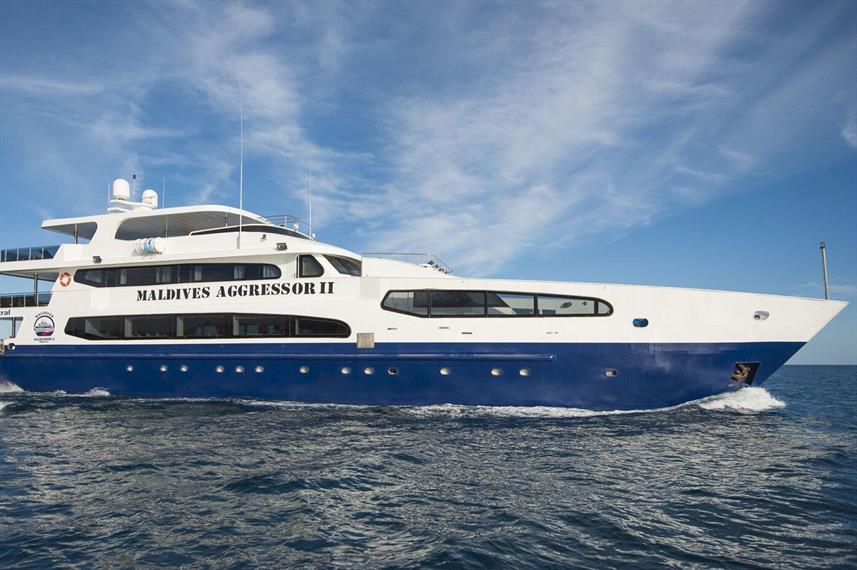
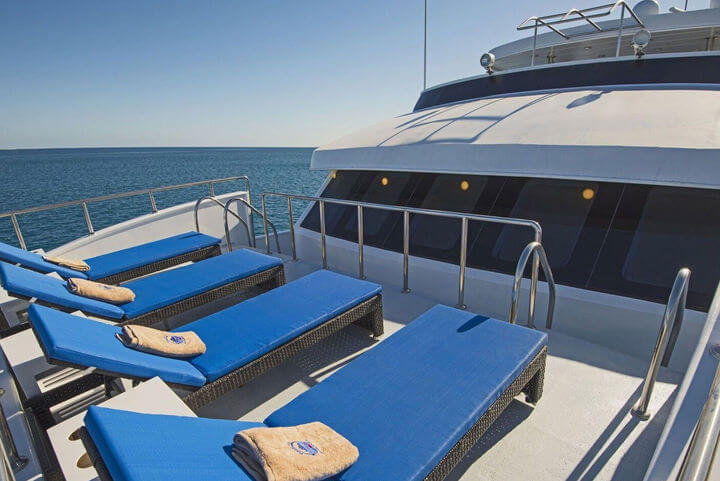
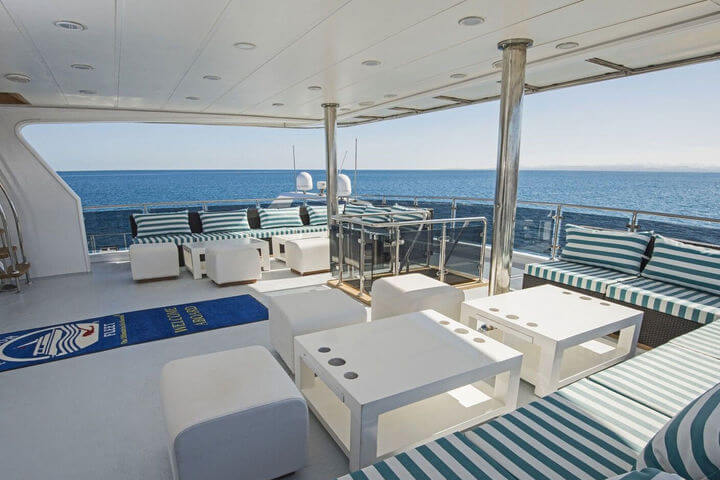
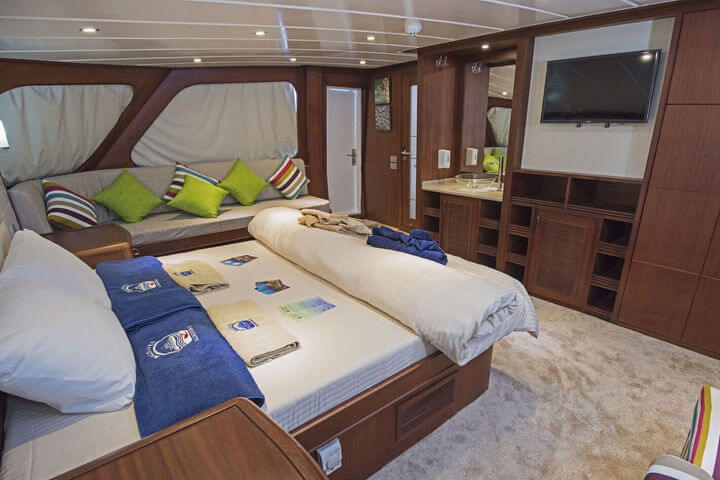
- Price: $$$ (Luxury Class)
- Central / North Atolls
- 7 – 10 Nights
- Experienced Staff, 5 Star Service, Off-The-Beaten-Track Dive Sites.
With 5 Star Service and exquisite dining, Maldives Aggressor II is another luxury class liveaboard; here guests can enjoy fine attentions to detail such as a morning beverage delivered to their cabins and an evening cabin turn-down service.
This is an extremely spacious yacht with big modern cabins featuring Private TV’s and huge common areas including a massive sundeck with jacuzzi, outdoor lounge and indoor saloon, dining and bar area where you can help yourself to fine wines, spirits and cocktails (the best part: all drinks are included in the main fee!).
Although Maldives Aggressor II doesn’t have as many extra facilities or activities compared to other luxury liveaboards like ScubaSpa Yang and White Pearl – for example there is no spa, cinema or gym; it has been operating quite a bit longer than them, having been built in 2006. As a result; the staff and operators seriously know what they’re doing!
Where this really shows; is the fact that Maldives Aggressor II is the only luxury class Maldives liveaboard to explore beyond the central atolls and venture into more off-the-beaten-track diving regions; specifically the Maldives far north which has the best coral in the country as well reef sharks and a huge abundance of manta ray cleaning stations!
5) Budget Value: Princess Sara
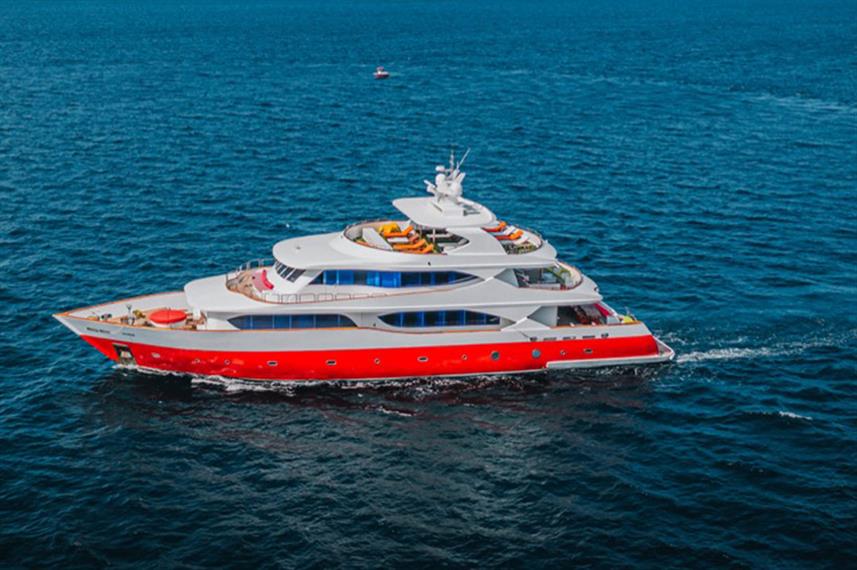
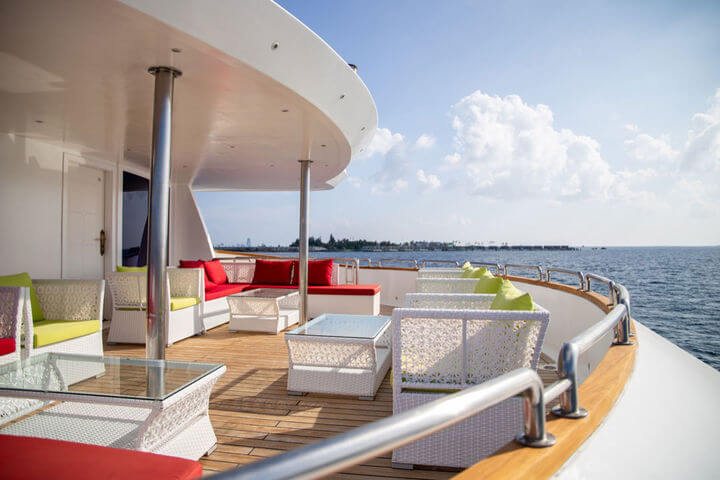
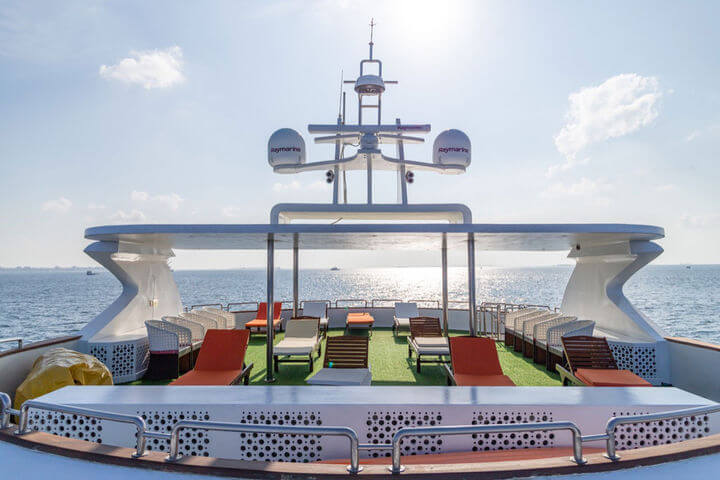
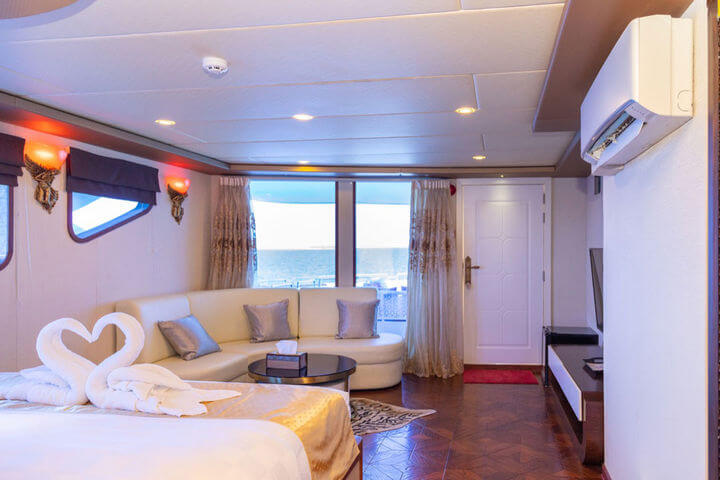
- Price: $ (Cheap)
- South + Central Atolls
- 7 Night Trips
- Jacuzzi, Jet Skis, Kayaks, Wakeboarding
- Awesome Value for Money
Princess Sara is one of the cheapest Maldives liveaboards of all time. Among those cheaper liveaboards it offers the best value for money on account of all the extra
activities including jet skiing and kayaking FOR FREE as well as a free beach bbq and the option to also go wakeboarding, get a massage or complete yoga sessions for extra.
Add to this a jacuzzi, impressive 40 meter length despite only taking 22 guests and plenty of bright, contemporary common areas including multiple outdoor lounges, a sundeck, indoor saloon & bar plus big cabins with private TV’s and in the case of the Master Suites; private balconies and you can see why it’s won our best value for money budget liveaboard award.
Furthermore, Princess Sara is also one of the very few Maldives liveaboards to operate trips to the more off-the-beaten-track south atolls where there are far less divers – and a lot more sharks including rarer species like threshers, hammerheads, tiger and bull sharks as well as those more commonly encounter around the central atolls like grey reef, nurse and whitetips.
The crew are very helpful; the chefs prepare delicious food, the dive guides excel at picking the best dive sites for the time of year and weather conditions whilst all of the staff are very friendly and professional.
6) Cheapest Maldives Liveaboard: Amba
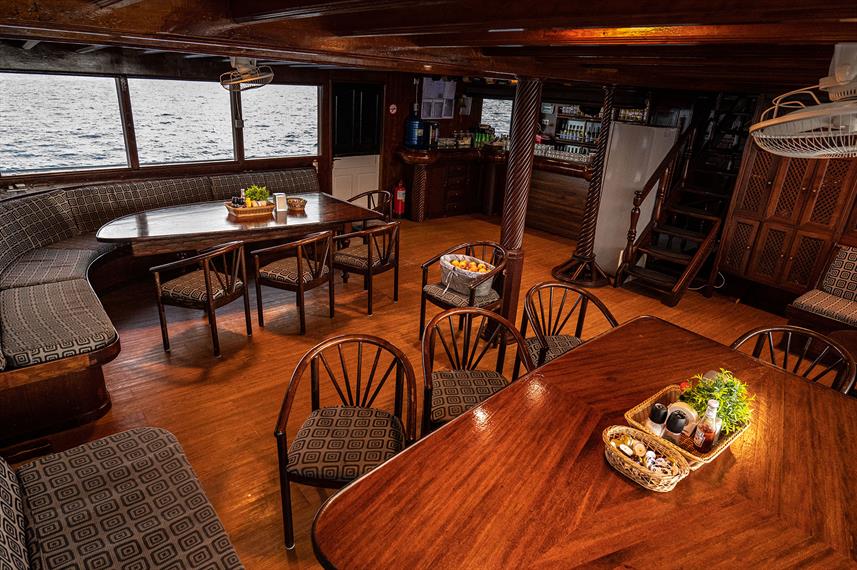
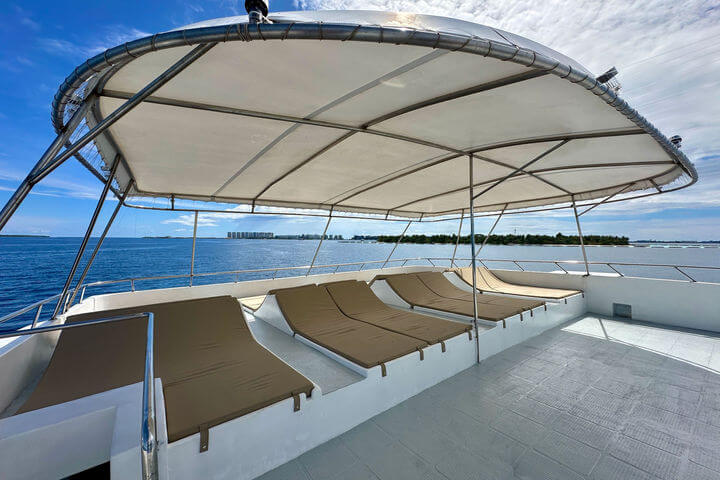
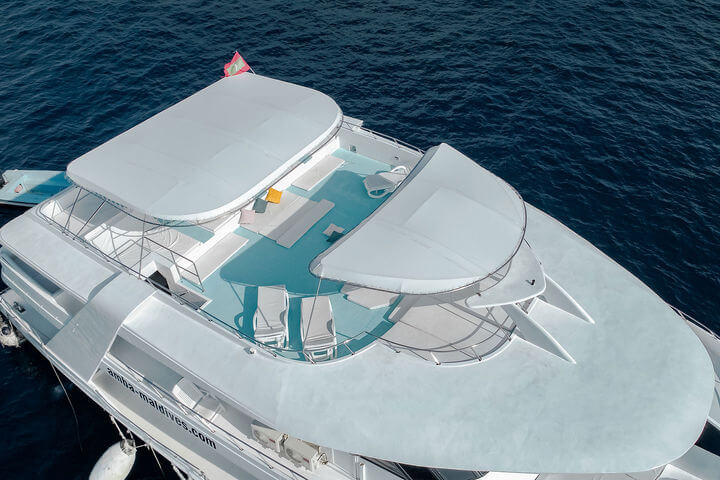
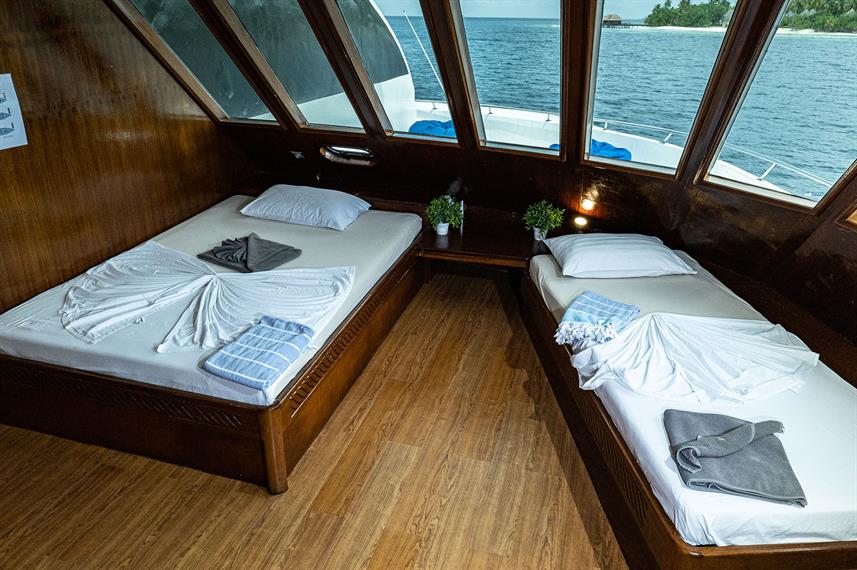
- Price: $ (Cheap)
- North + Central Atolls
- 7 – 11 Night Trips
- Private Terrace Cabins
- Beginner Friendly Trips
Amba is the all-time cheapest Maldives liveaboard we could find – so if you want to save as much money as possible whilst still going on a kickass diving safari with a liveaboard; this is the one to go for!
There are several exciting dive itineraries on offer including 7 – 11 night trips around the famous Central Atolls – as well as to the North Atolls. No other cheap liveaboard visits these North Atolls but this region has the best coral in the Maldives as well as many of the usual suspects found around the central atolls like manta rays and reef sharks.
In addition to this, 7 night Beginners Trips around the Central Atolls are sometimes available. These itineraries are designed to primarily include easier dive sites that divers with only their open water certification can still go on.
At 30 meters long, Amba takes 22 guests and has some very nice cabin options; all cabins have ensuite bathrooms, aircon and single or double bed configurations whilst the luxury cabins on the top deck each have a large and secluded private terrace overlooking the ocean. Wow!
Amba doesn’t have many extra activities – there’s no kayaks or watersports. There is also no mention of a beach bbq, which may explain why it’s that little bit cheaper than other budget liveaboards. However; in terms of the quality of its dive itineraries, cabins, food and staff friendliness; Amba offers fantastic value for money whilst being the cheapest Maldives liveaboard.
7) Traditional Design / South Atolls: Nautilus Two
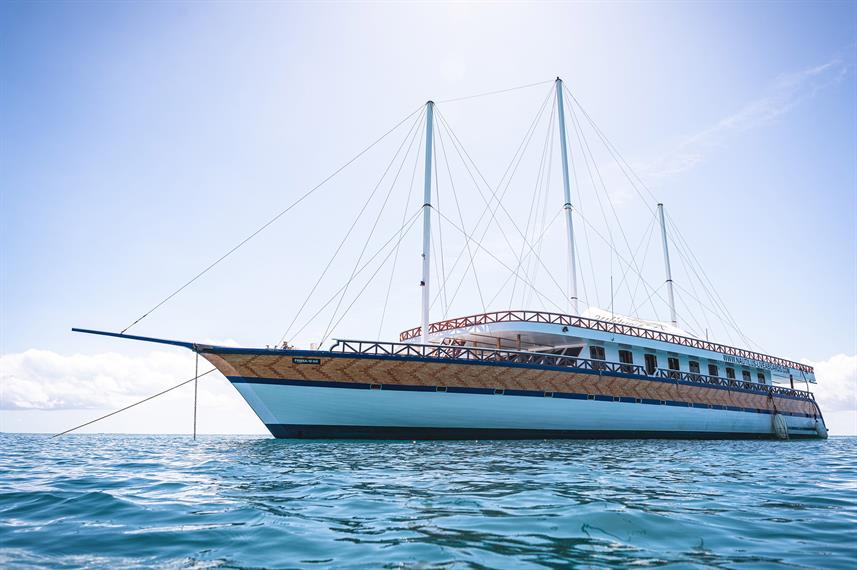
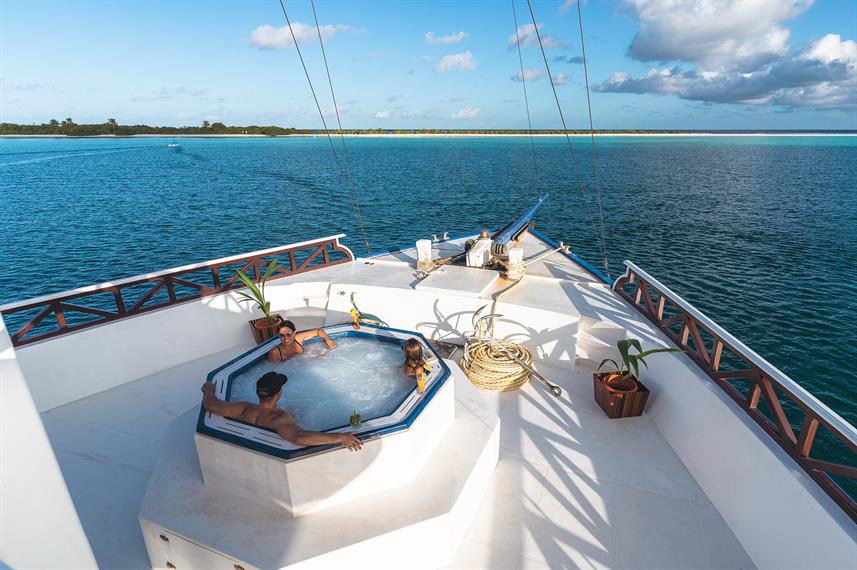
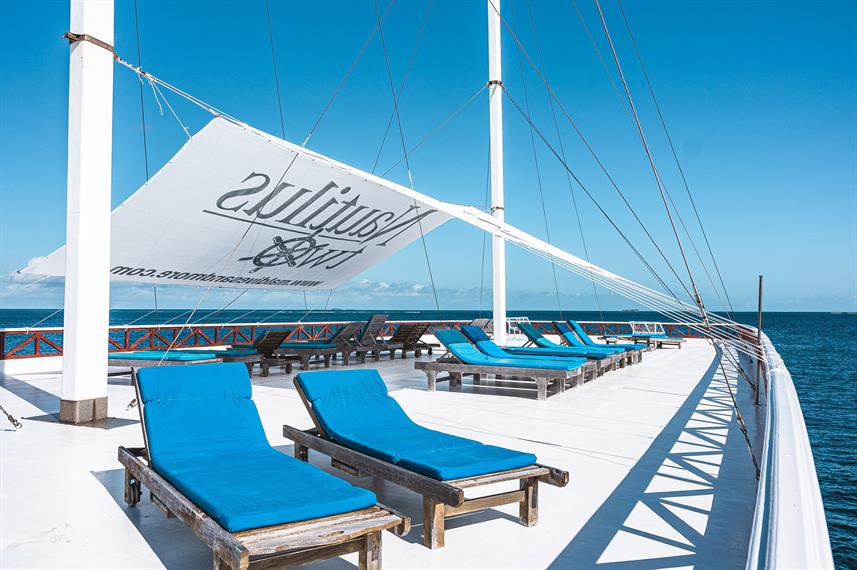
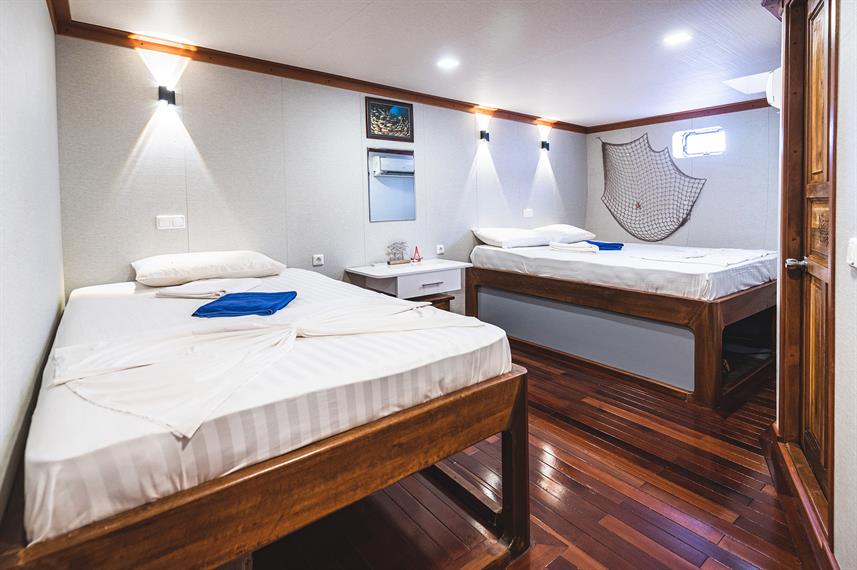
- Price: $ (Cheap)
- South + Central Atolls
- 7 – 12 Night Trips
- Traditional Design, Jacuzzi, Massage Showers
There’s no denying that Nautilus Two is one of the most beautiful looking liveaboards in the Maldives. Whereas most Maldives Liveaboards are modern yachts, Nautilus Two follows a traditional Maldivian design with a stunning incorporation of local hardwood into the exterior and interior. At 43 meters long, it is also a little longer than most other liveaboards.
Despite being so affordable, Nautilus Two still boasts a hot tub, massage showers and spacious cabins with beautiful wooden interiors as well as delicious food and friendly, experienced staff!
Also Nautilus Two normally explores the South Atolls which have epic drift dives and rarer shark species such as hammerhead, tiger and thresher sharks as well as the various reef shark species usually found around the central atolls.
Hardly any other cheap Maldives liveaboards visit the off-the-beaten-track South Region of the Maldives and of those that do, Nautilus Two goes there the most frequently.
8) Best Mid-Pricer: Emperor Explorer
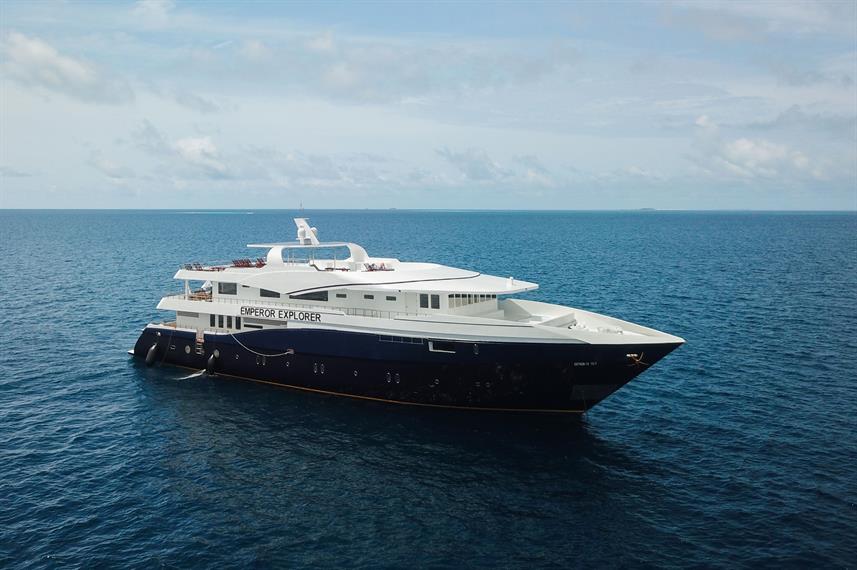
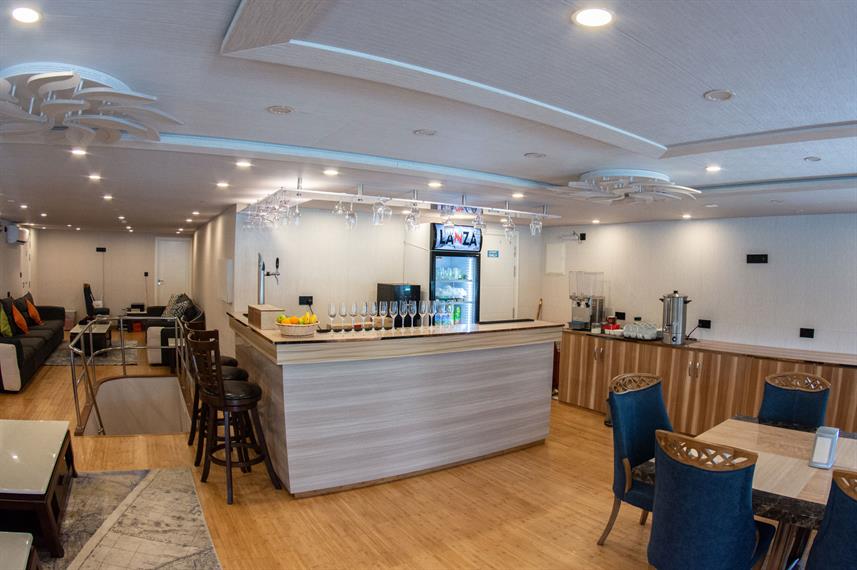
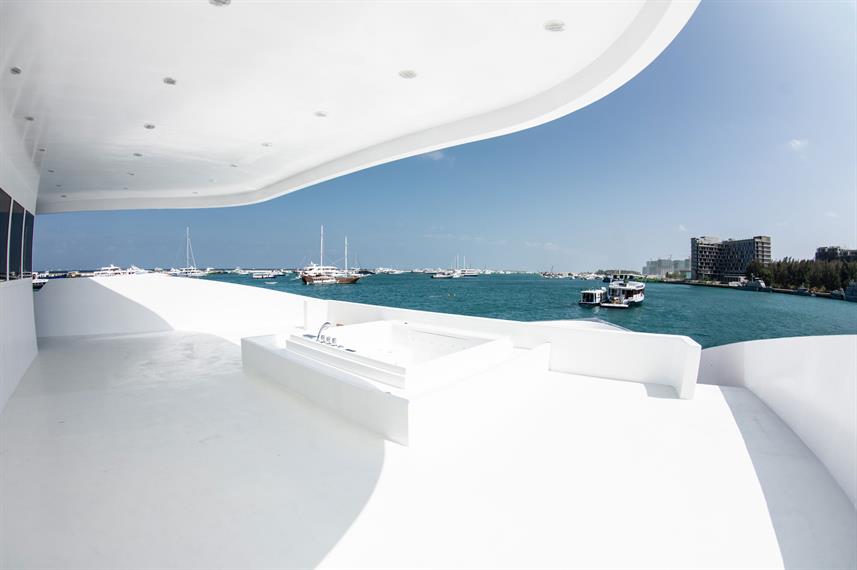
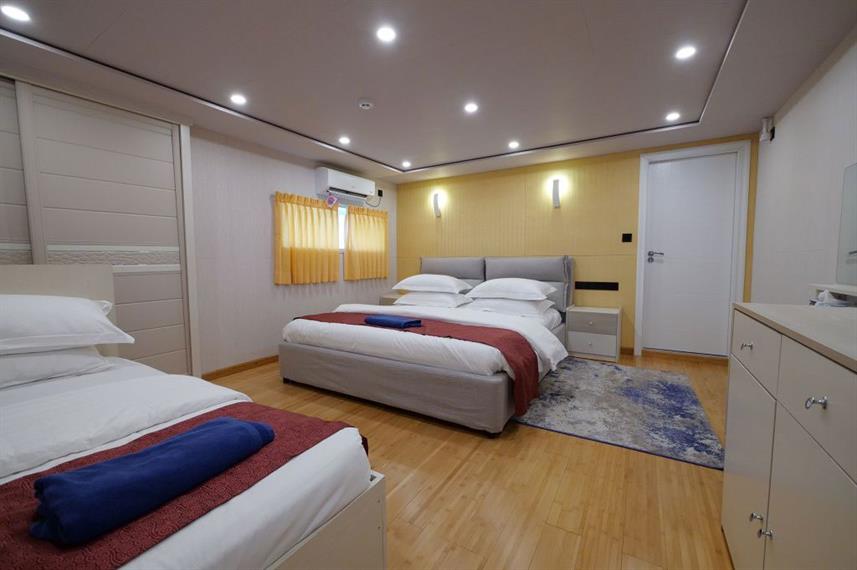
- Price: $$ (Mid-Price)
- South / Central / North Atolls
- 7 – 12 Night Trips
- Extended Trips & Off-Beaten-Track Dive Sites
- Happy Hour, Free Wine!
- Extra Dives
In my opinion, Emperor Explorer is the best mid-priced Maldives liveaboard in terms of value for money and quality of diving itineraries. For starters, it’s one of the only liveaboards to regularly operate trips around the Central, North and Far South atolls so you can discover some of the Maldives most off-the-beaten-track dive sites in whichever region you like.
Constructed in 2019, it is the newest and fanciest edition to the highly reputable Emperor Fleet who have many years of experience. Whereas most Maldives liveaboards offer 2 – 3 dives a day, Emperor Explorer tends to offer 3 – 4 so you get extra dives!
On the top deck of Emperor Explorer is a large sundeck with a jacuzzi and plenty of loungers as well as a shaded area where you can get a massage from the onboard masseuse.
Down on the main deck is the partially shaded outdoor lounge and this leads into the spacious indoor saloon, bar and dining area where guests are treated to a complimentary glass of wine with dinner! There’s also 2 for 1 happy hour before dinner! All cabins feature plenty of space and ensuite bathrooms and some also offer ocean views.
9) Solo Traveller Cabins: Carpe Novo
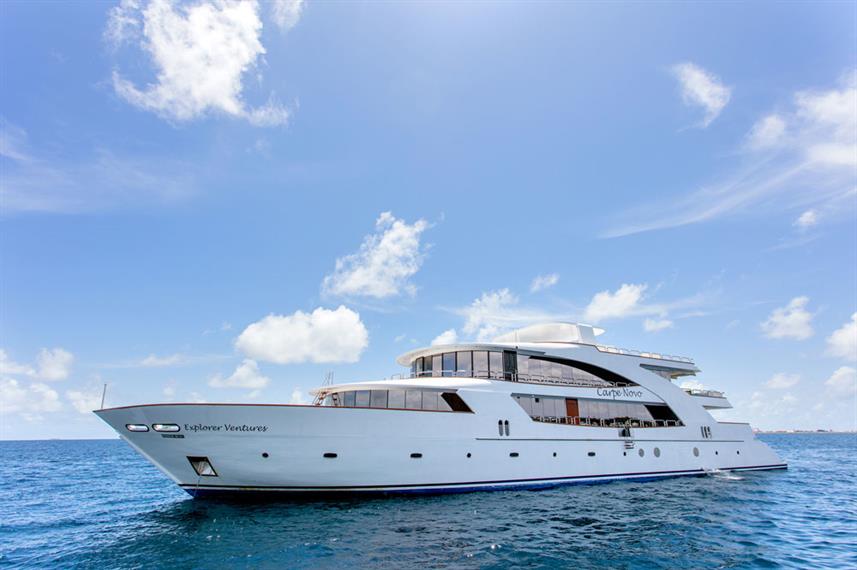
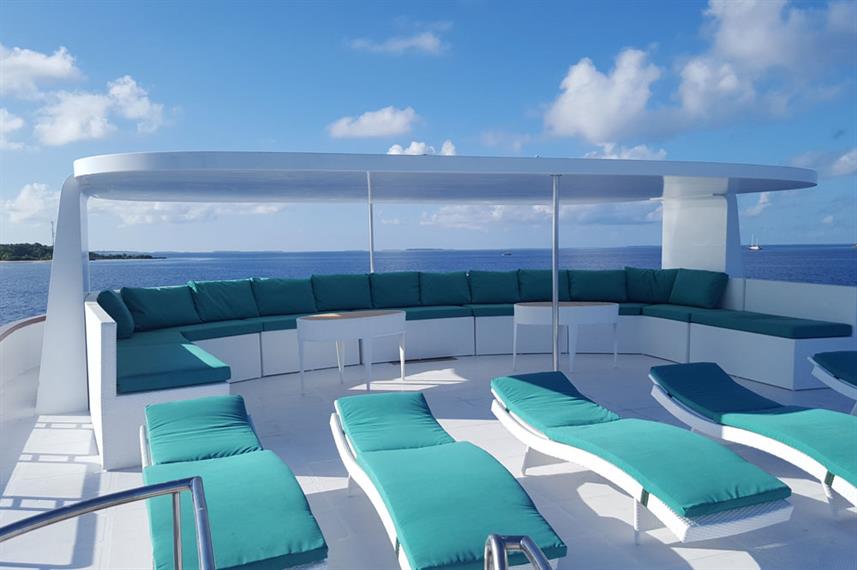
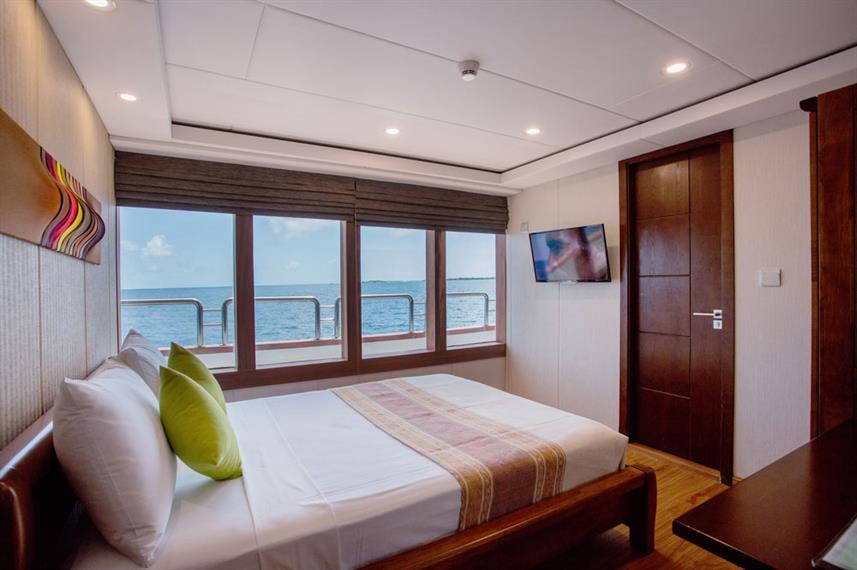
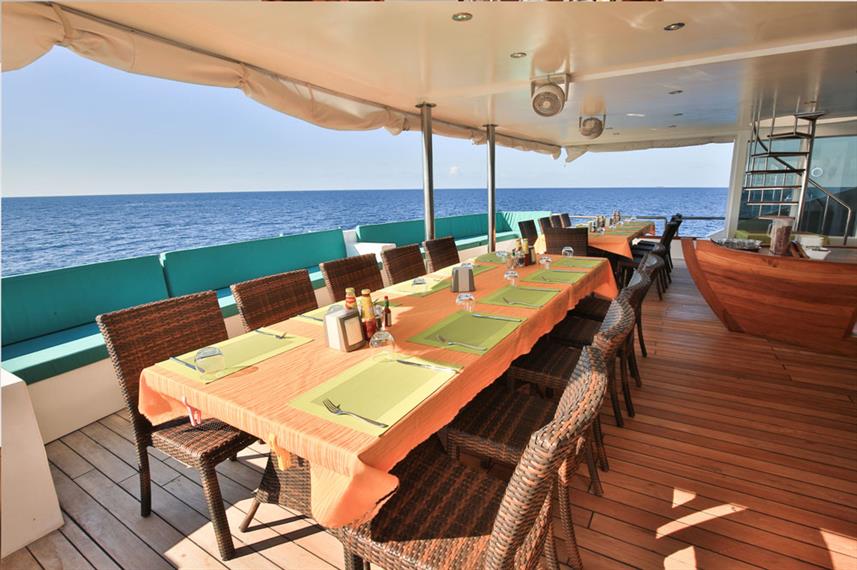
- Price: $$ (Mid-Price)
- South / Central / North Atolls
- 7 – 10 Night Trips
- Solo Traveller Cabin options. All cabins have private TVs.
Usually, when a solo traveller books a liveaboard then end up sharing a twin cabin with a stranger. Not so with the Cape Novo!
There are 2 Solo Suites with queen beds and ocean views; ideal for divers travelling on their own. There are also another 10 cabins: 4 Junior Suites and 6 Standards with twin and double bed configurations. All cabins have Private TVs, ensuite bathrooms and ample storage space.
This is a nice liveaboard to stay on; at 43 meters long and taking a maximum of 22 guests, Carpe Novo feels very roomy. A large, partially shaded terrace offers outdoor dining and there is also a spacious sundeck for working on your tan! Plus, there’s also an interior living room with TV entertainment, indoor dining and bar zone.
Trips last 7 – 10- nights and whilst most cover the famous central atolls, a few times a year it’s also possible to journey to the more rarely visited North or South atolls.
10) Fanciest Mid-Pricer: Duke of York
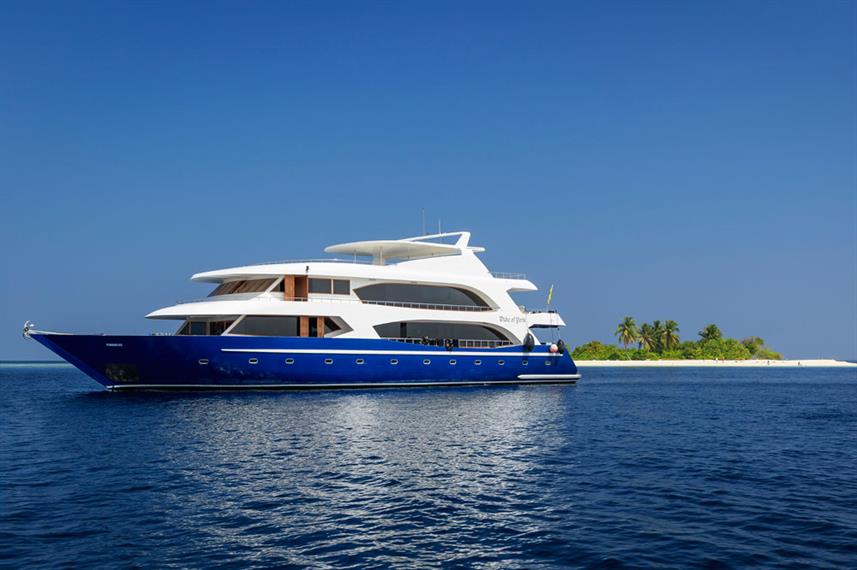
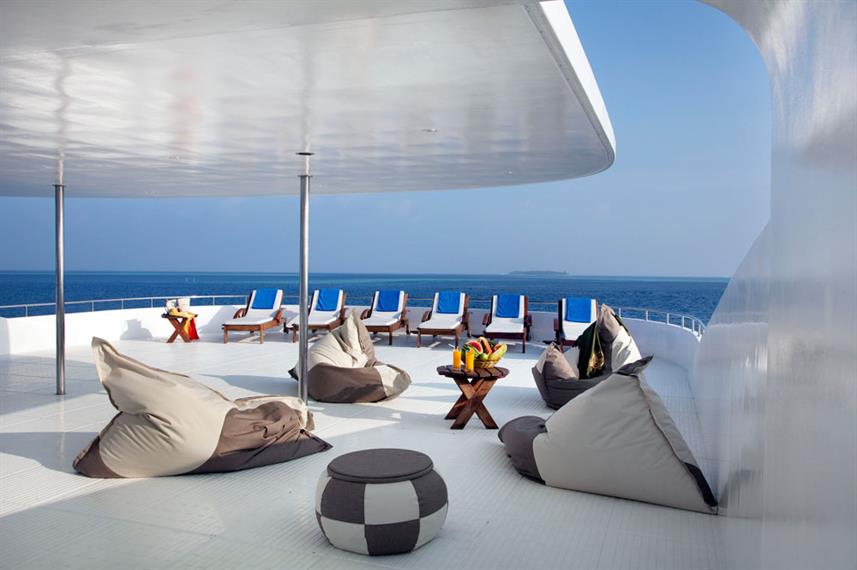
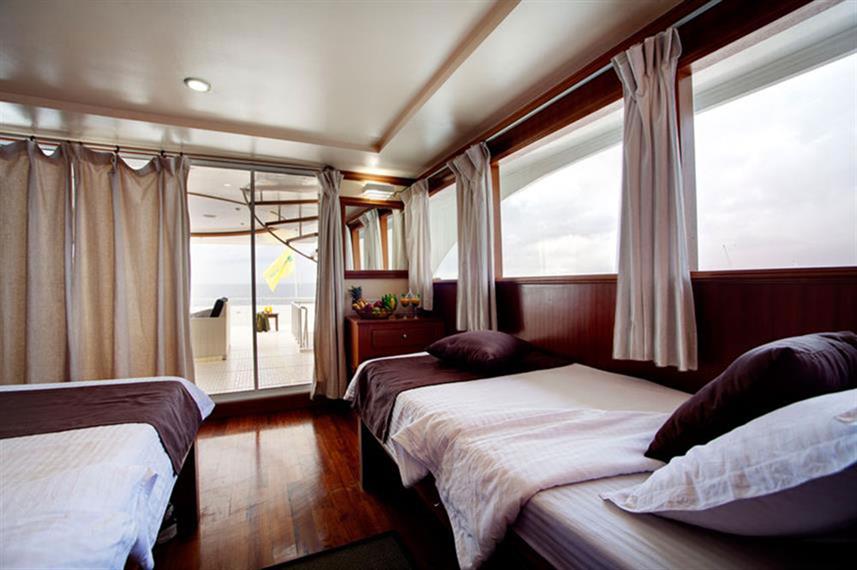
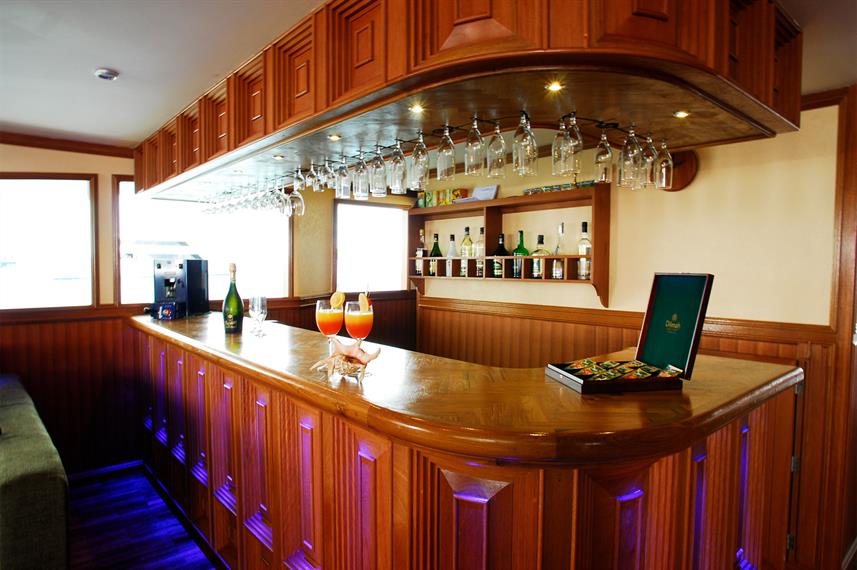
- Price: $$ (Mid-Price)
- Central / South / North Atolls
- 2 – 10 Night Trips
- Shorter Trips (2, 3, 5 Nights)
- Massages, Kayaks, Underwater Scooter
Duke of York is technically only mid-priced but it feels a little classier it’s similarly priced brethren with a very sleek, stylish layout, contemporary lighting and modern furnishings.
Impressively, there are 3 huge sundecks, an indoor lounge, bar and dining zone with TV entertainment system as well as free kayaks and even an underwater scooter.
There are a total of 10 cabins; all feature ensuite shower rooms and beautiful wooden interiors with some also offering huge ocean views.
Most trips explore the famous Central Atolls of the Maldives although on certain months of the year it’s also possible to venture to the more rarely visited South or North Atolls. Also, shorter trips of 2, 3 or 5 nights are sometimes available which is rare for any liveaboard.
11) Deep Relaxation: Conte Max
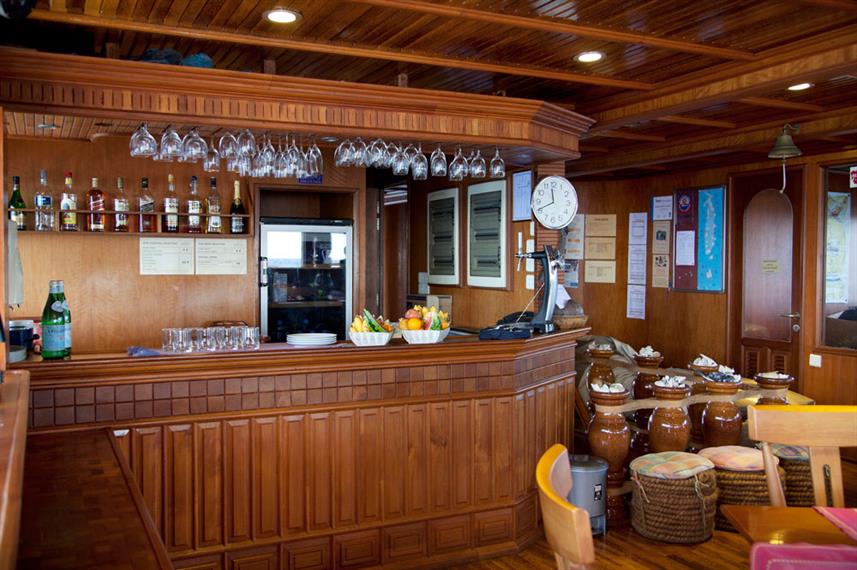
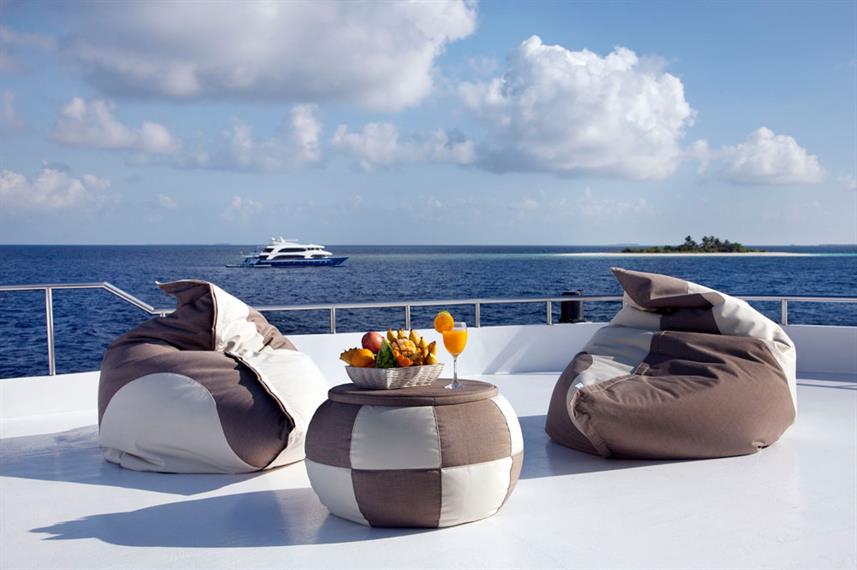
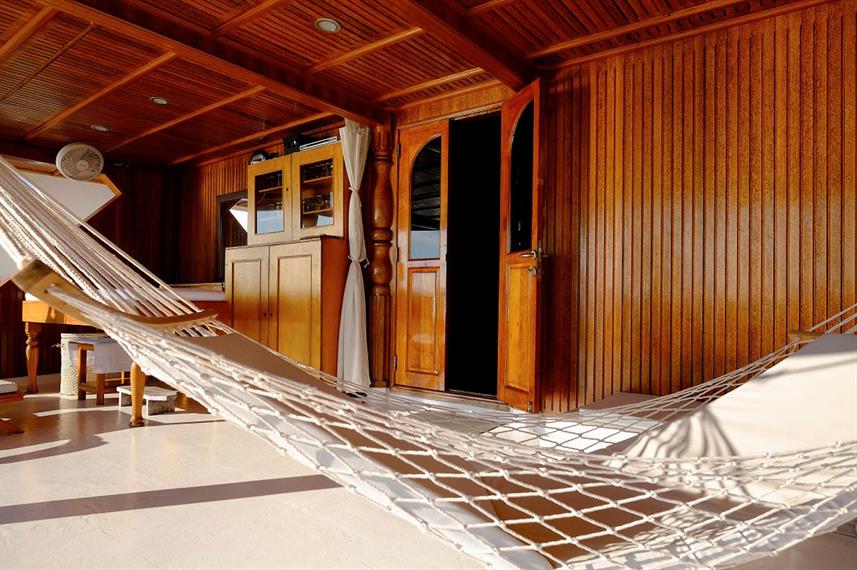
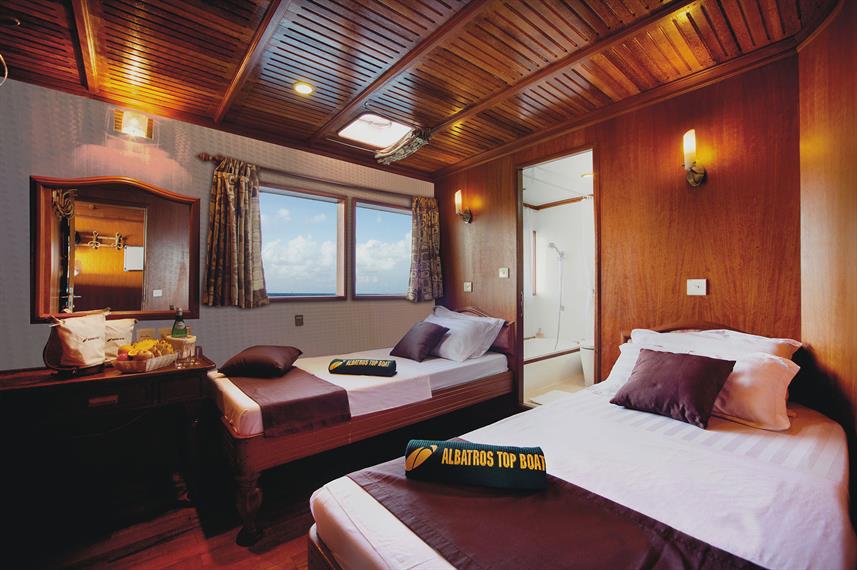
- Price: $$ (Mid-Price)
- Central / South / North Atolls
- 2 – 10 Night Trips
- Deep Relaxation Focused
- Ayurveda Centre: Yoga, Meditation, Masssage
Conte Max is a highly popular liveaboard and a unique one at that. Onboard, there’s a wellbeing centre with an Ayurveda specialist who can guide guests through yoga, and offer individual massage treatment.
The crew go above and beyond at creating an incredibly laid back and tranquil vibe whilst the dive guides are very professional and have an incredible knowledgeable of the local marine ecosystem.
Catering to a maximum of 21 guests, there are 9 cabins; all with ensuite bathrooms, aircon and a beautiful hardwood interior. Upper deck cabins have stunning ocean views.
There is a partially shaded lounge as well as a sundeck and partially shaded outdoor lounge with beanbags, sundecks and hammocks. As well as indoor dining, outdoor dining is also available so you can dine beneath the stars.
Trips typically last 2 – 10 nights, allowing for some shorter trip options and explore either the Central, North or South atolls of the Maldives.
12) Laura’s Top Pick: Iruvai
- Price: $$ (Mid-Price)
- Central Atolls
- 7 Night Trips
- Great for Spanish Speakers
“Iruvai has a local hardwood interior which makes her extremely homely and cozy; even more so thanks to the many lush plants potted everywhere.
With 10 cabins (including a master option with it’s own bathtub) plus a spacious lounge, bar, sun terrace and dining zones, she is a roomy and comfortable vessel to be on; twenty maximum guests is a smaller group size than most other Maldives liveaboard and during my trip it really felt like a tightly nit and intimate group which was super nice.
The dive itinerary was extremely varied; we saw mantas, countless nurse and guitar sharks on night dives, huge schools of reef fish and brightly coloured coral reefs as well as turtles, grey reef sharks and more”!
13) Private Balcony Cabins (+ Solo Option): Adora
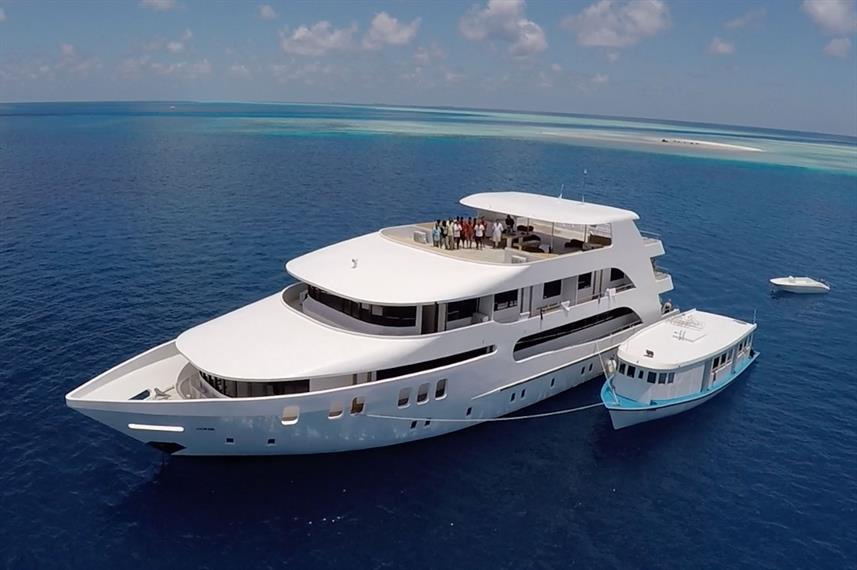
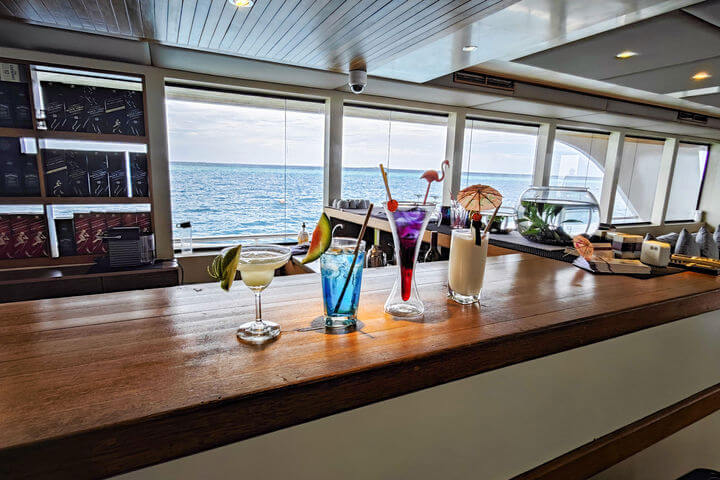
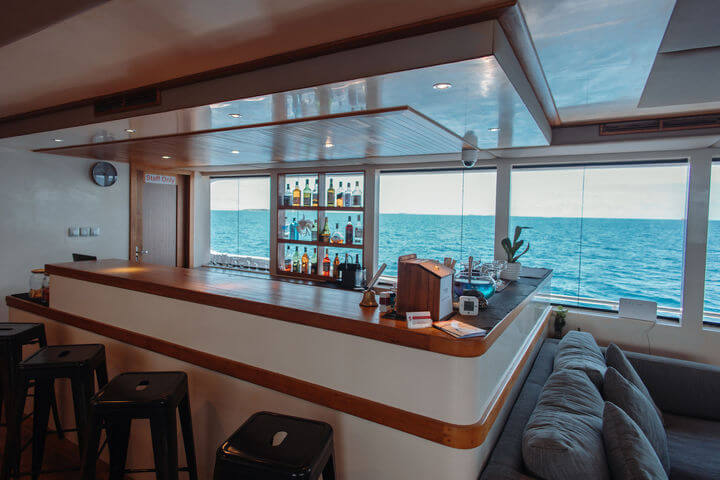
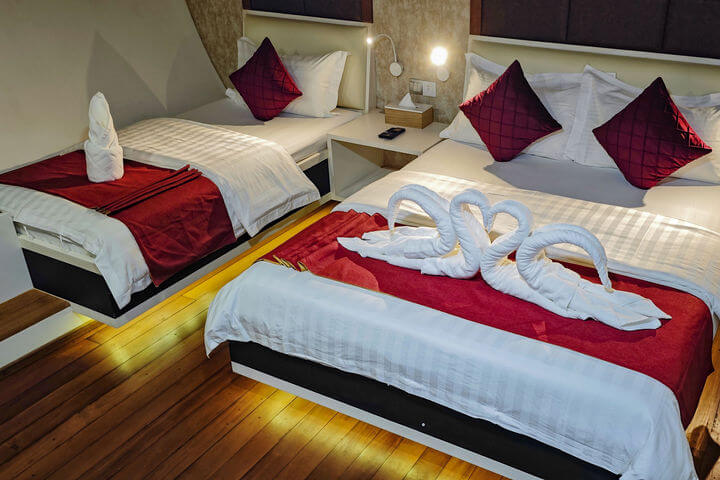
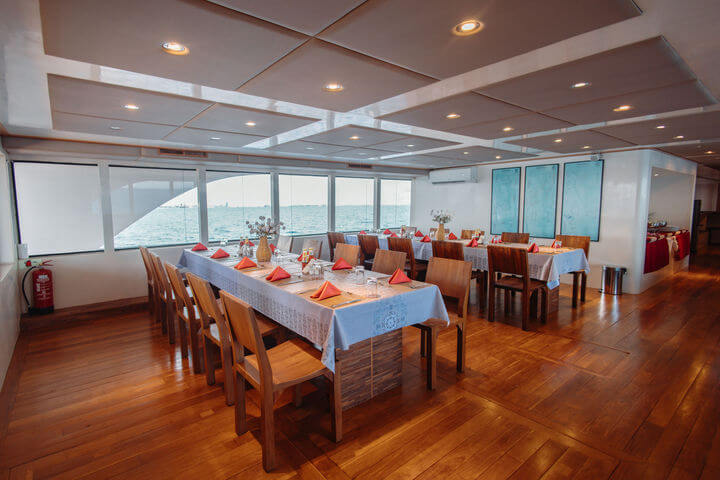
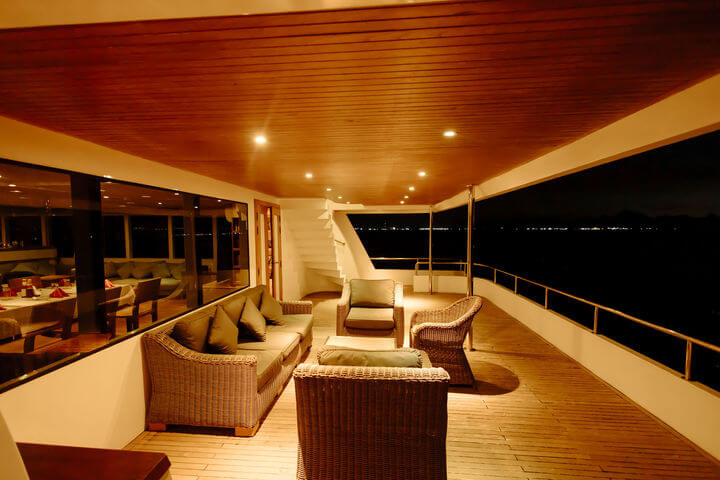
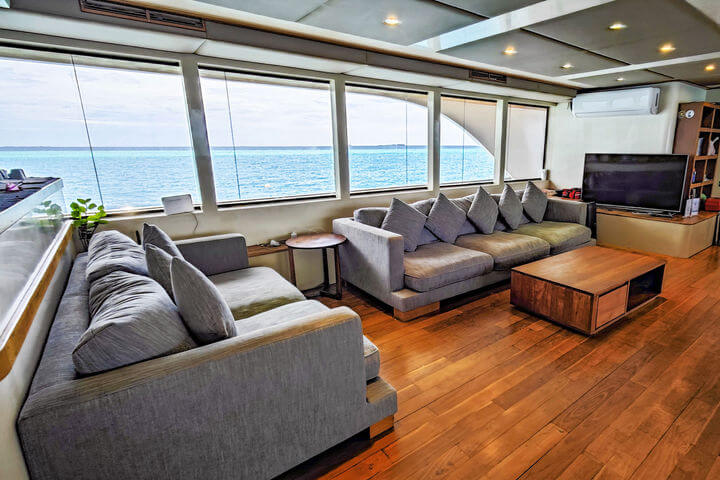
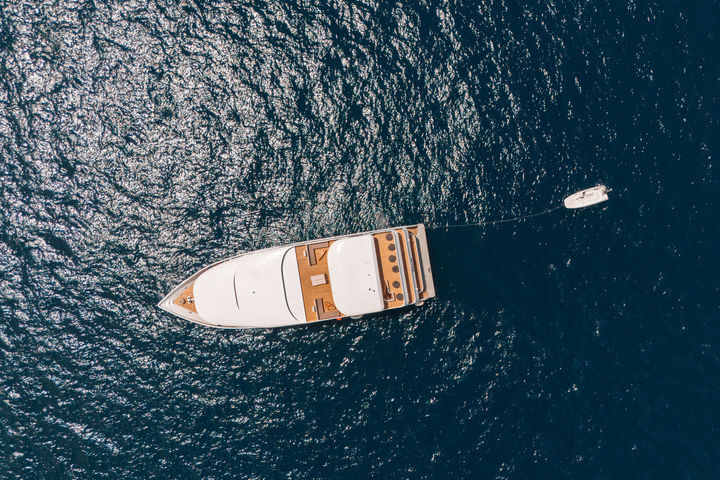
- Price: $$ (Mid-Price)
- Central / South Atolls
- 7 – 10 Night Trips
- 4 Double “OceanView Suites” with Private Balcony
- 1 Solo Traveller’s Cabin
Adora has some of the best cabins of any mid-priced Maldives liveaboard! On the upper deck are 4 Ocean View Suites with private balcony plus a double and single bed, minibar, charging sockets and large window. The “Superior Single” cabin is on the middle deck and has a queen bed and windows. Finally on the lower deck are 6 standard cabins with double + single bed.
All cabins are 9 meters squared and have TVs as well as ensuite bathrooms, air conditioning, storage space, minibar and charging sockets.
Taking just 22 guests and at 37 meters long, Adora is a beautiful liveaboard to stay on. It is partly built using local hardwoods and has very nice common areas including an outdoor sun lounge, indoor saloon and bar area where the talented chef serves up delicious cuisine from the Maldives, India and Sri Lanka.
Most trips are 7 nights long and explore the Central Atolls but 10 night trips that combine diving around the central atolls with the Maldives south region are also sometimes available.
14) Value for Money: Emperor Serenity
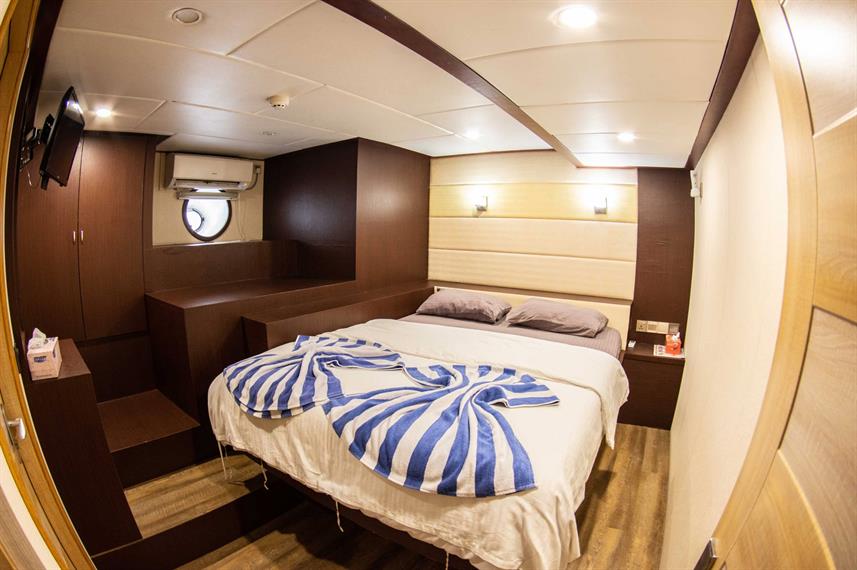
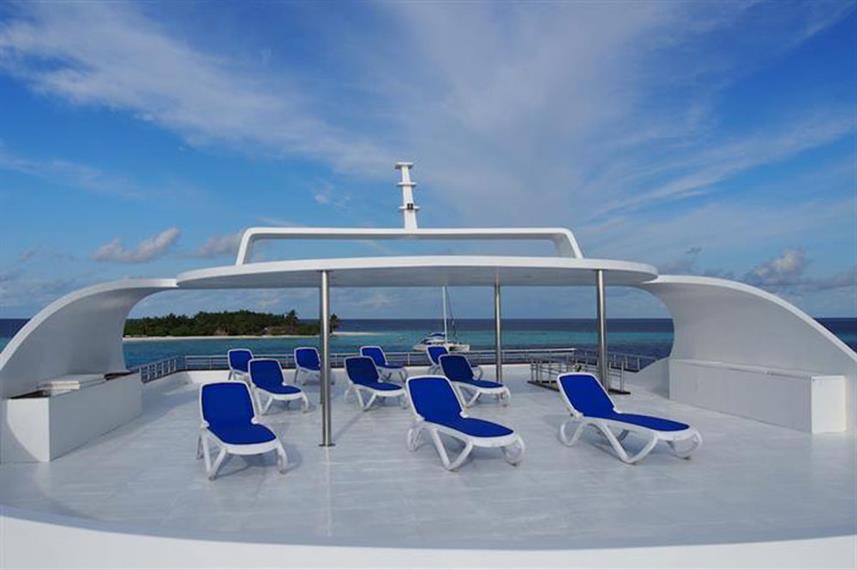
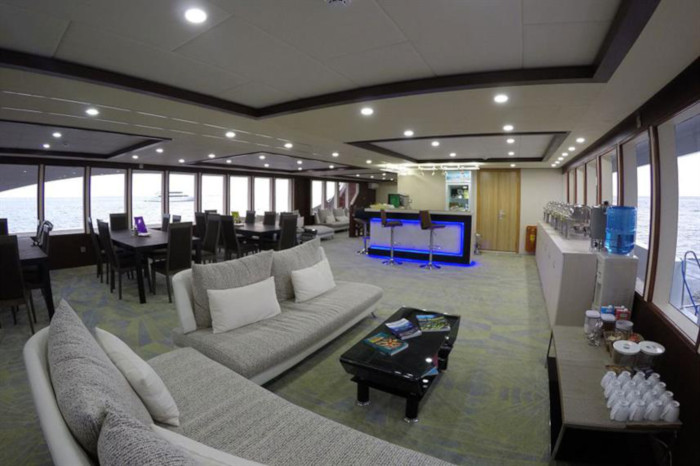
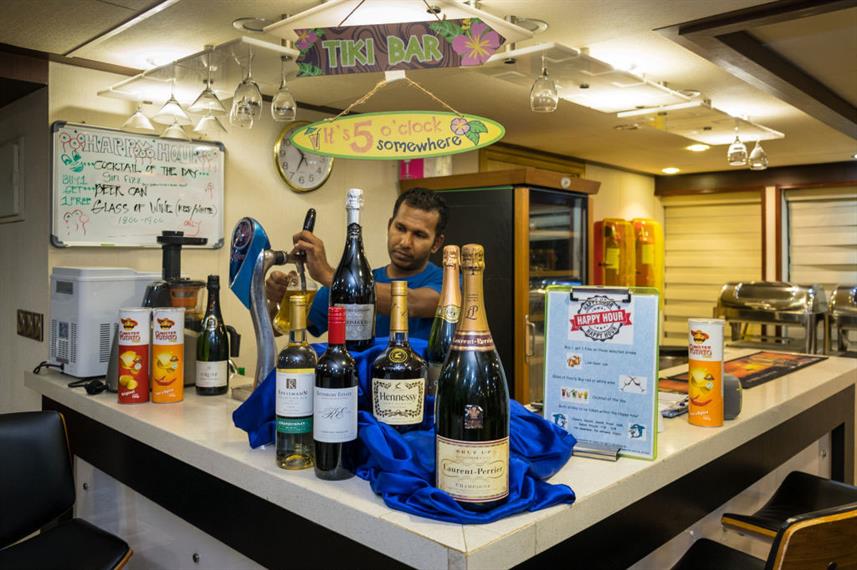
- Price: $$ (Mid-Price)
- Central / South /North Atolls
- 7 – 14 Night Trips
- Extended Trips
- Free Wine & Happy Hours!
Although it still sits within the mid-price range for Maldives liveaboards, Emperor Serenity is actually a little less expensive compared to the rest. This, combined with the FREE Nitrox, Free Wine and Happy Hour (2 drinks for 1 before dinner!) makes it a great value for money option.
On some months, Emperor Serenity runs the longest scuba diving trip of any Maldives liveaboard – a whopping 14 night long “Southern Shark Adventure” that combines the best dive sites of the Central Atolls with those of the more rarely visited South Atolls. Standard 7 night trips around the Central Region are also offered. Most trips include a sunset barbecue on the beach.
Emperor Serenity is 40 meters long and caters to a maximum of 26 guests in 13 cabins; all of which have twin or double bed configurations and include ensuite bathrooms and aircon. The staff all very friendly and professional and ready to make your diving trip a memorable one!
15) Extended Central Exploration: Blue Voyager
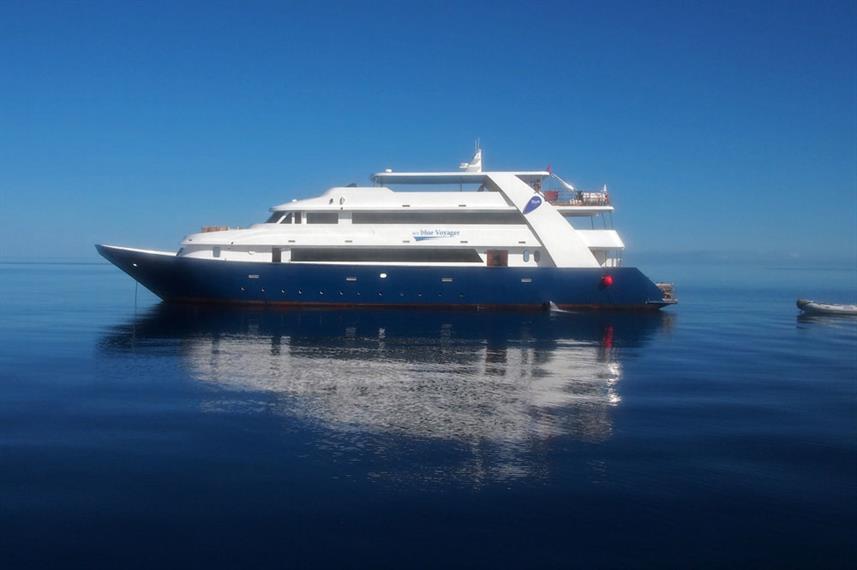

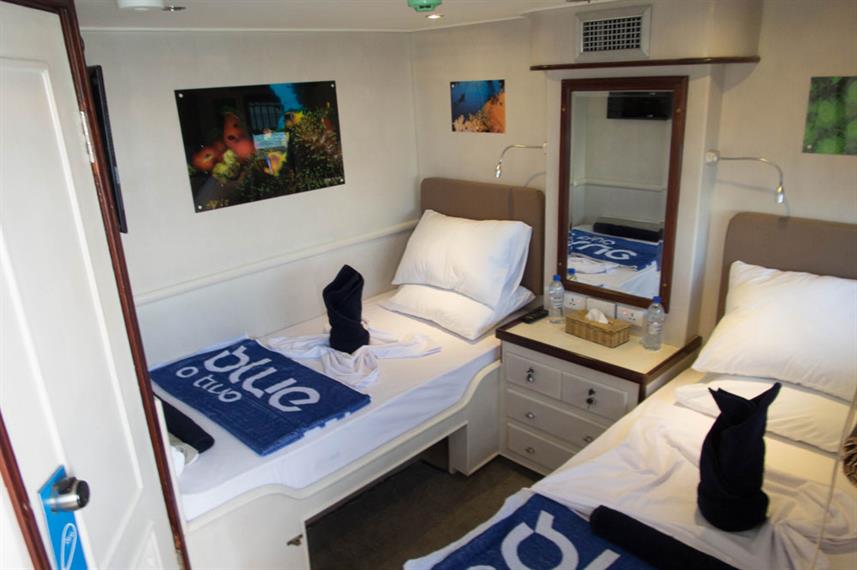
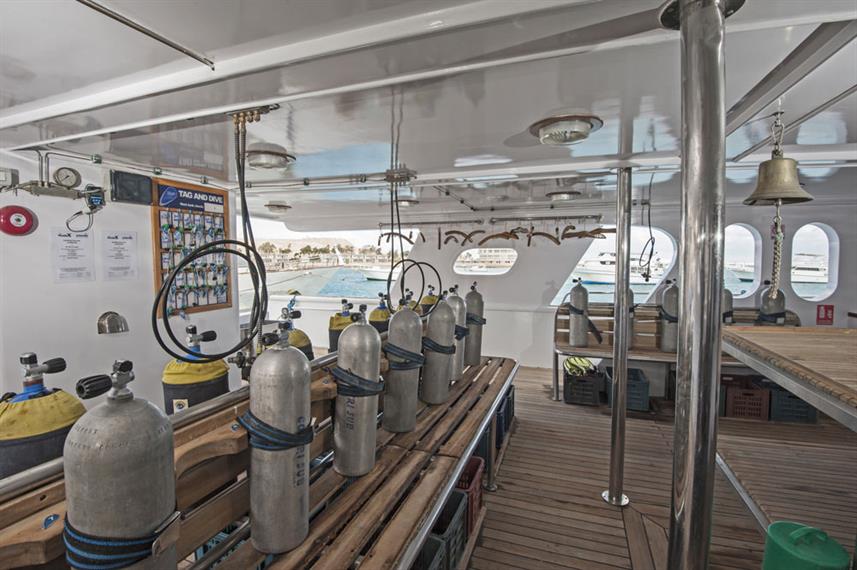
- Price: $$ (Mid-Price)
- Central / North / South Atolls
- 7 – 10 Night Trips
- TVs in Cabins
- Jacuzzi
Blue Voyager is another slightly cheaper mid-priced Maldives liveabaord with great value for money; especially thanks to the Private TV in every cabin and the Jacuzzi located on the outdoor lounge.
This is the one of the only liveaboards in the Maldives to offer extended trips around the Central Atolls that last 10 nights, allowing guests to discover more Central Region dive sites – including ones that are rareley featured on other liveaboard trips.
In addition to this, standard 7 night trips around the Central Atolls are also available as well as 7 – 10 night trips around the more off-the-beaten-track north or south atolls.
Also, Blue Voyager is one of the very few Maldives liveaboards to have a dive deck onboard – most other liveaboards rely on a Dhoni (although Blue Voyager does have a dhoni as well!).
What to Expect on a Maldives Liveaboard Trip
(Click here to Ascend back up to Maldives Liveaboard Reviews).
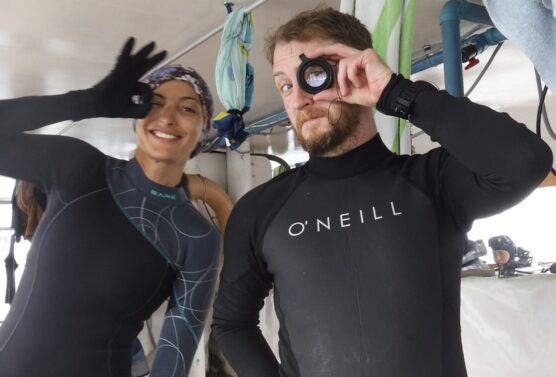
In this section I’ll tell you everything that occurs when you go on the incredible experience of a Maldives liveaboard:
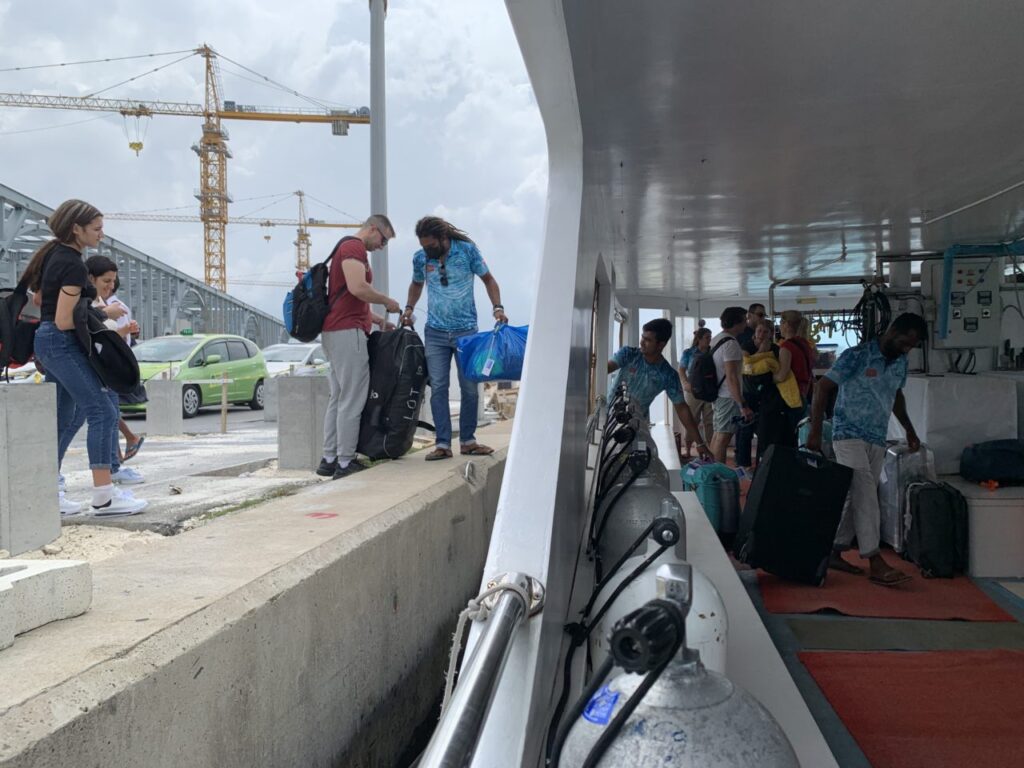
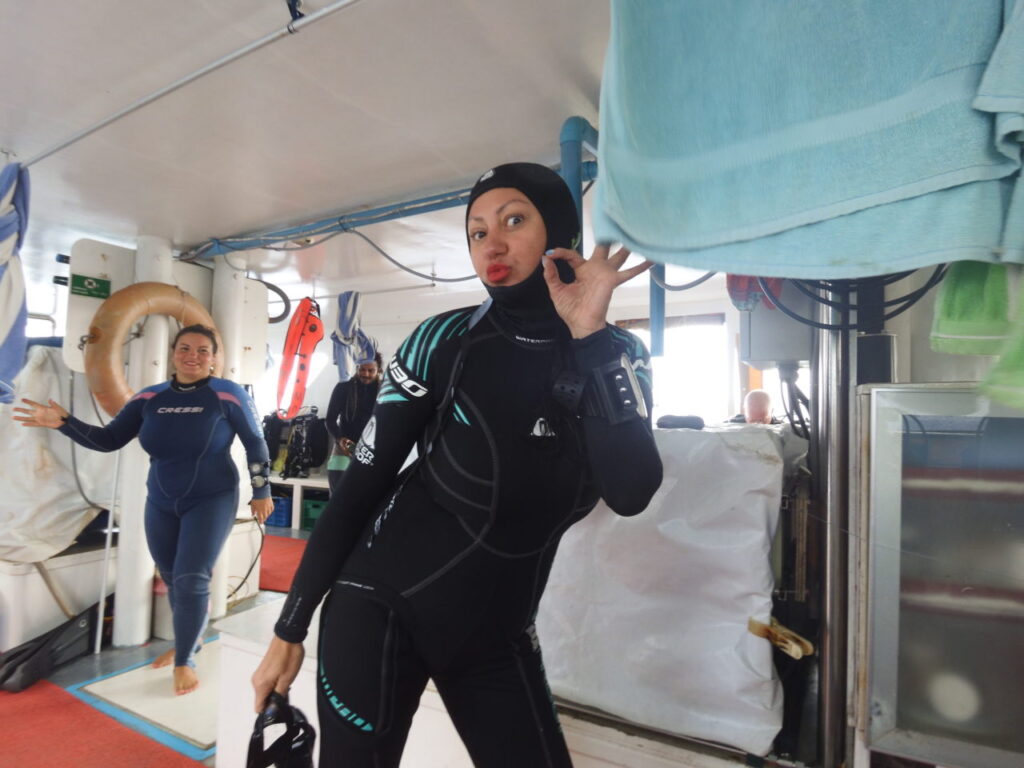
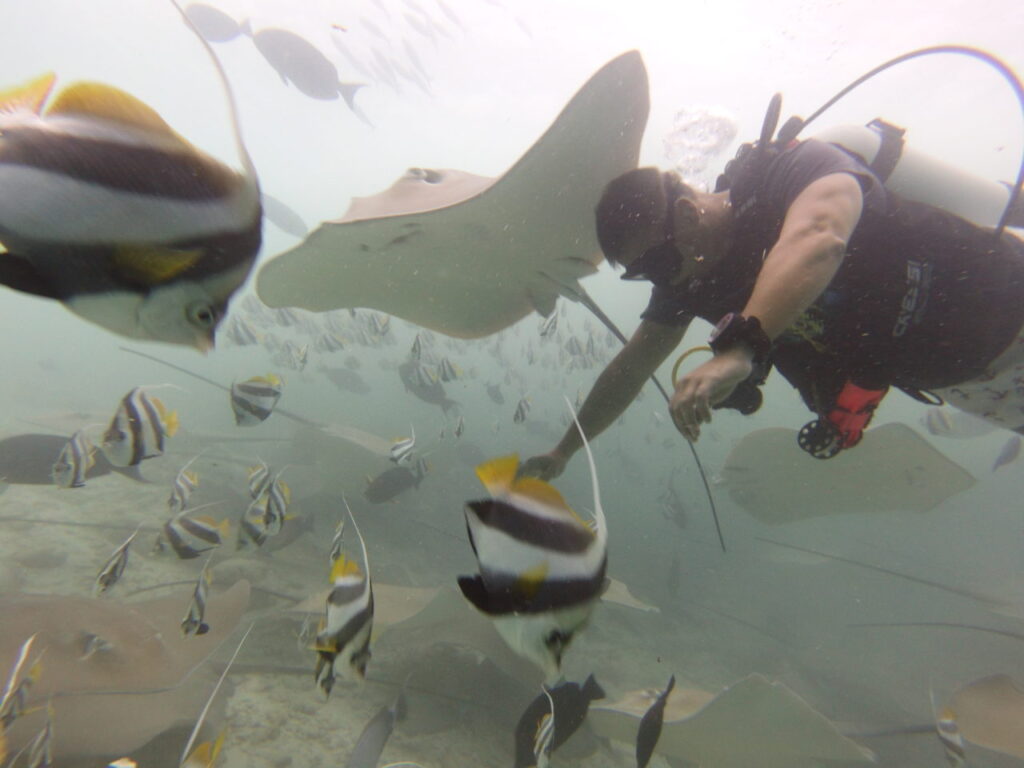
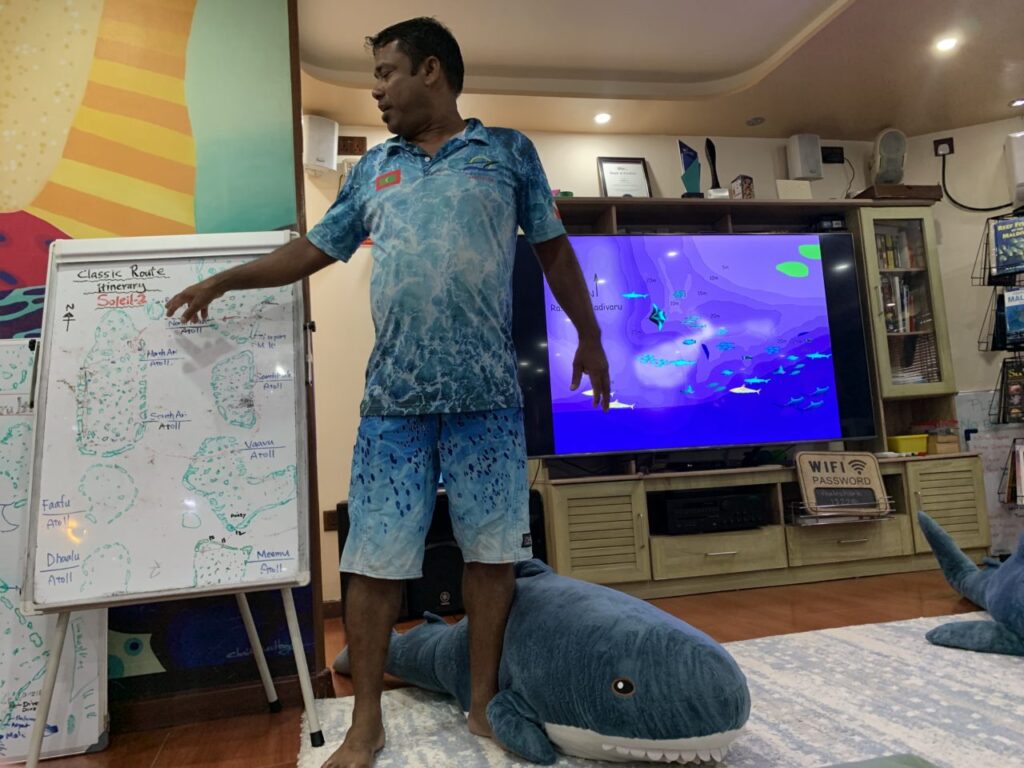
BOOKING a Maldives Liveaboard
There’s something I want to tell you. You saw those big old orange buttons under each of the liveaboard reviews further up this page? The one’s that say “Check on LiveAboard”. I’m talking about these little dudes:
When you click one of these it takes you to the schedule and booking page for that individual liveaboard on liveaboard.com.
Liveaboard.com is a huge collection of liveaboards in countries all over the world, including the Maldives. You can use it to check the availability of and reserve spaces on hundreds of different liveaboards.
Hovering over the green “RESERVE NOW” button in the right hand corner – or imply scrolling down, shows guest spaces for all upcoming trips for that liveaboard.
When you find the perfect date and trip for you, clicking the green button “SELECT” shows you different cabin options – for a small extra cost you can choose an extra fancy cabin. Some of the more expensive cabins have really cool features like private balconies.
There’s a short description for each cabin type under the cabin selection page.Finally select the green button “CONTINUE TO STEP 2” and fill out your personal details to reserve that liveaboard. Now, when you do all this after clicking through one of those green links on Diving Squad, we get a small affiliate commission at no extra cost to yourself. Thankyou!!
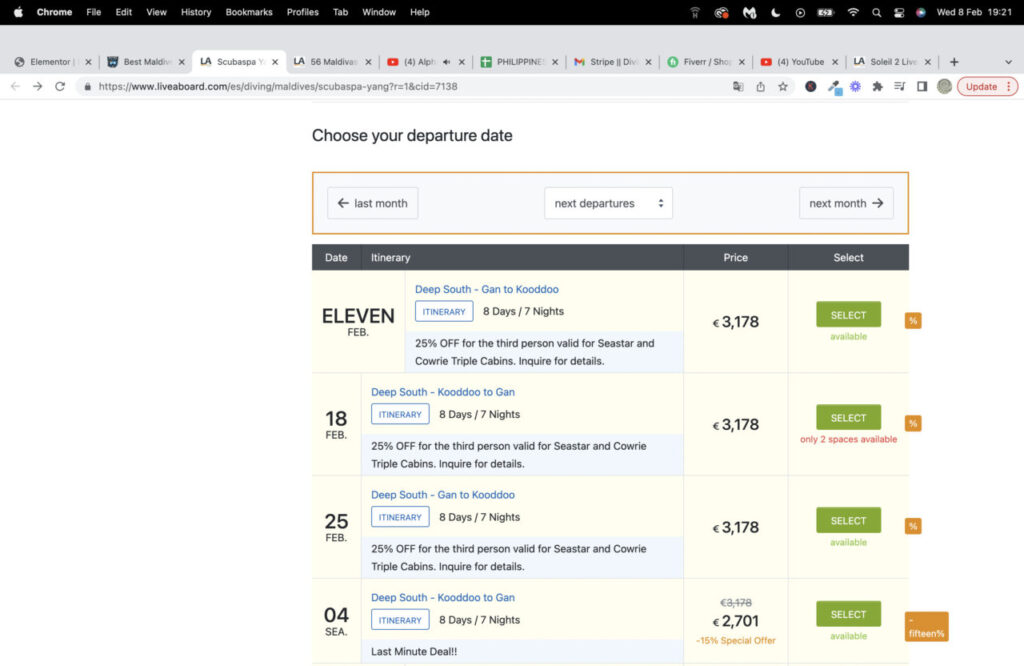
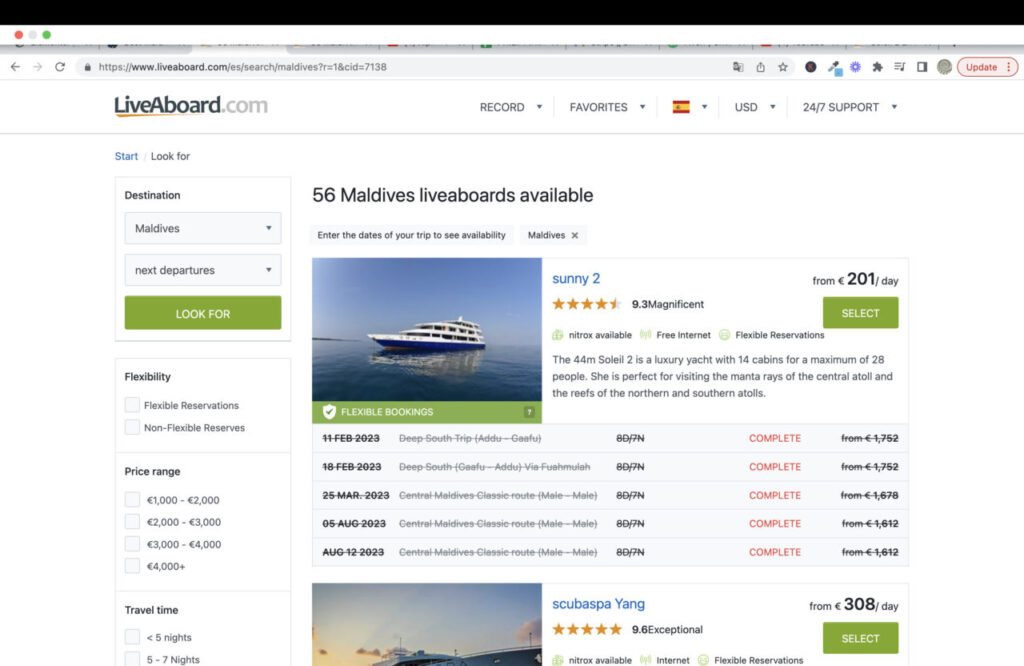
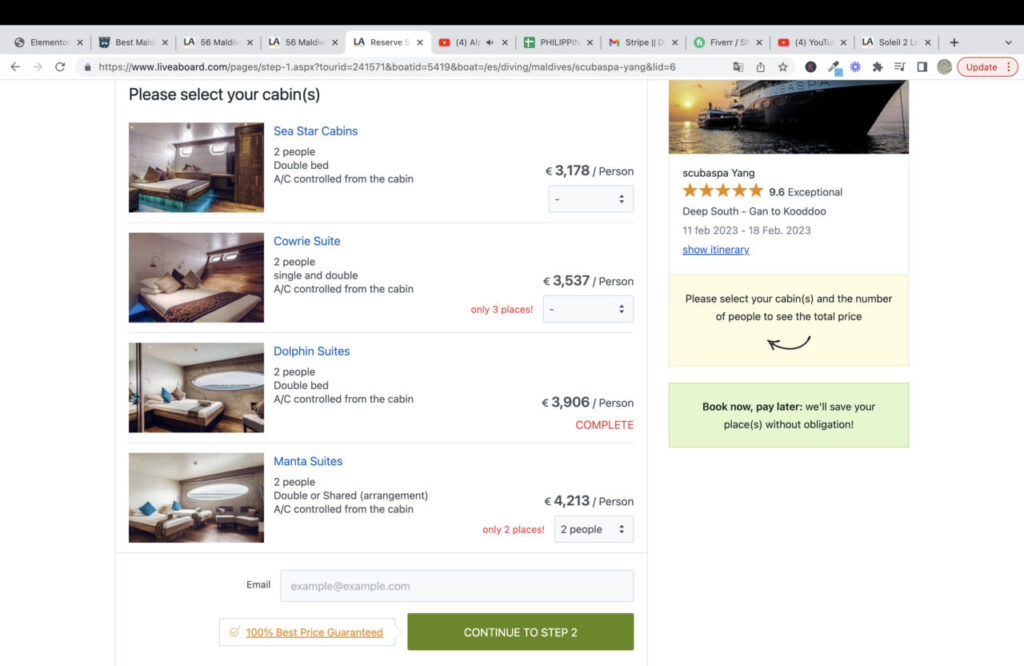
This doesn’t change your experience of booking a liveaboard at all; you’re almost guaranteed to book any liveaboard on liveaboard.com as it’s the world’s most popular online liveaboard booking service with tons of variety and awesome deals. And it doesn’t cost a cent extra.
But it helps us a butt-ton by providing tasty funds which we can throw at keeping this site fresh and sexy whilst continuing to delve out into the world to gather new Diving Squad content. Gracias!!
Head’s up: it’s not uncommon for liveaboard trips to fill out months in advance!! So plan ahead. That said, there are over 50 different liveaboards in the Maldives so you can usually find an option even at the last minute. However, having the freedom to choose among a wide selection requires booking in advance.
How to Get To the Maldives
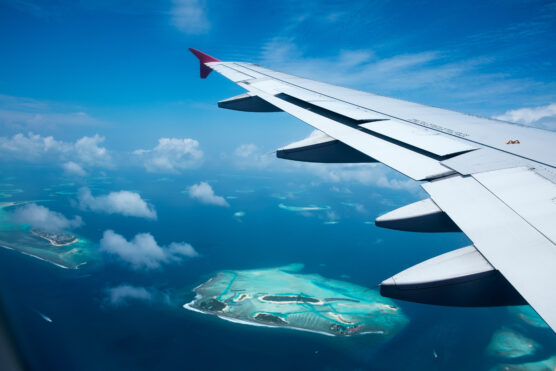
The main international airport of the Maldives is Velana, which is located on Male in the central region. Normally Velana is where you will fly into. Staff from your Maldives liveaboard will greet you at the airport to escort you to your ferry.
If you’re going on a liveaboard that explores the far north or deep south regions of the Maldives, you may catch a short domestic flight from Velana to one of the northern or southern region airports – this doesn’t happen often but if it does for your trip, your liveaboard will explain everything.
The Maldives requires that international visitors have a passport that is valid for six months from their expected departure date as well as proof of sufficient funds and an outward travel plan.
Border staff can be a little picky at Velana; it’s the only airport my passport was ever scrutinised for having a minor tear (fortunately they didn’t see the paper-cut induced blood stains that were on several of other pages!). You will automatically be granted a 30 day visa on arrival which can be extended to 90 days if requested.
What’s it like going on a Maldives Liveaboard?
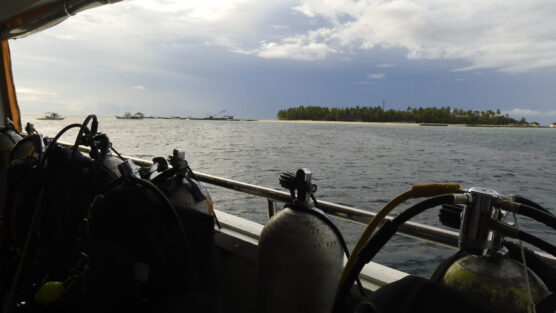
After you’ve boarded your liveaboard, organised your dive gear and been shown to your cabin to unpack the rest of your stuff, there’s an orientation briefing.
In this, everything from the liveaboard layout to health & safety is explained and diving groups are assigned (they try to group similarly experienced divers together).
The first one or two dives of the trip are always around an especially easy dive site. This is where you’ll work through any issues e.g. making sure your gear is functioning properly.After this first day, which is very much about getting orientated, your daily routine looks like this:
- Wake-up call at around 7am. About twenty minutes to grab a coffee and snack.
- First dive briefing and dive of the day. Followed by breakfast.
- About 90 minutes break. Good time to sneak in a nap!
- Second dive. Lunch.
- About one and a half to two hours break.
- Third dive. Dinner.
- Extra activity – can be night dive, beach bbq, fishing etc.
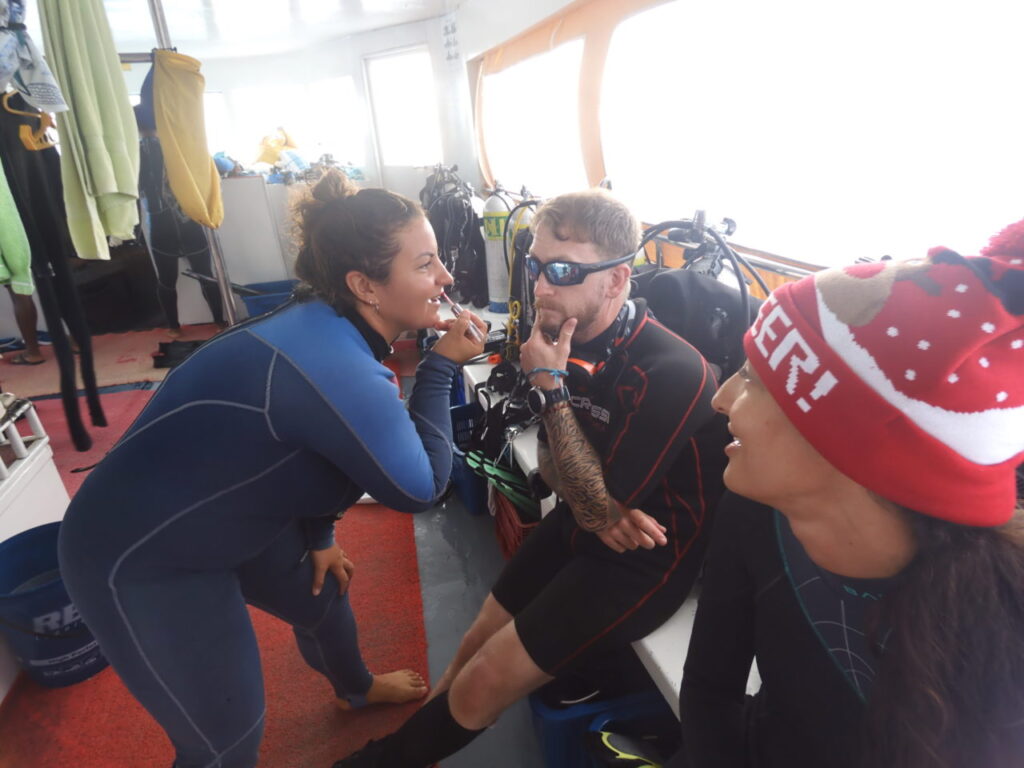
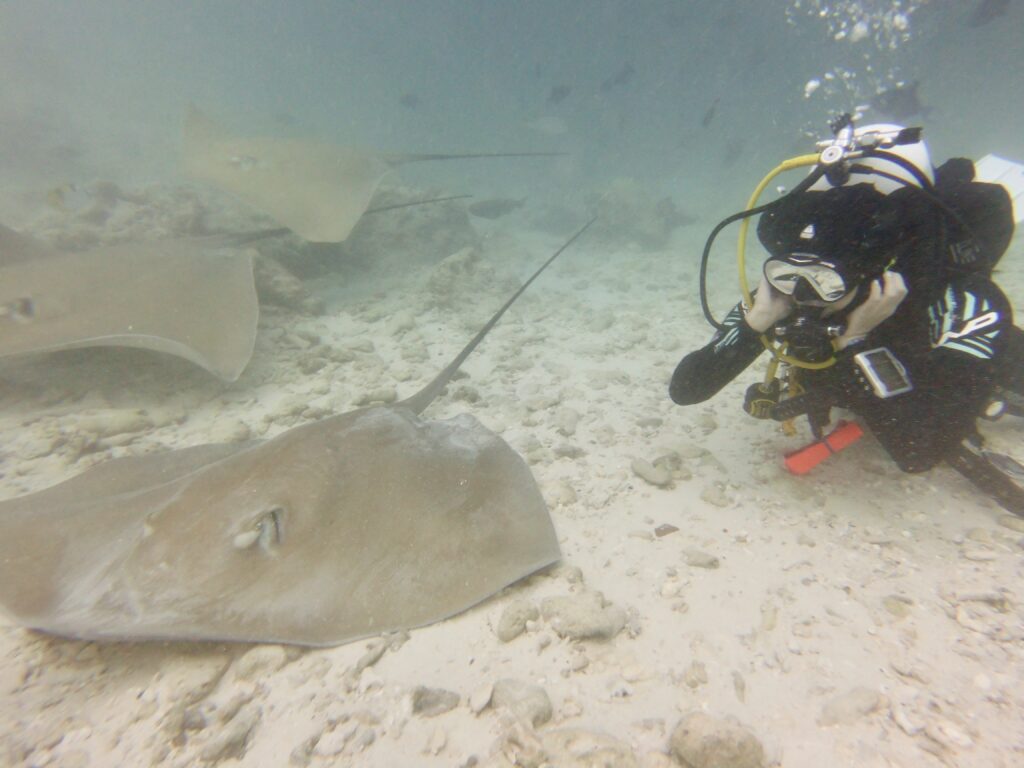
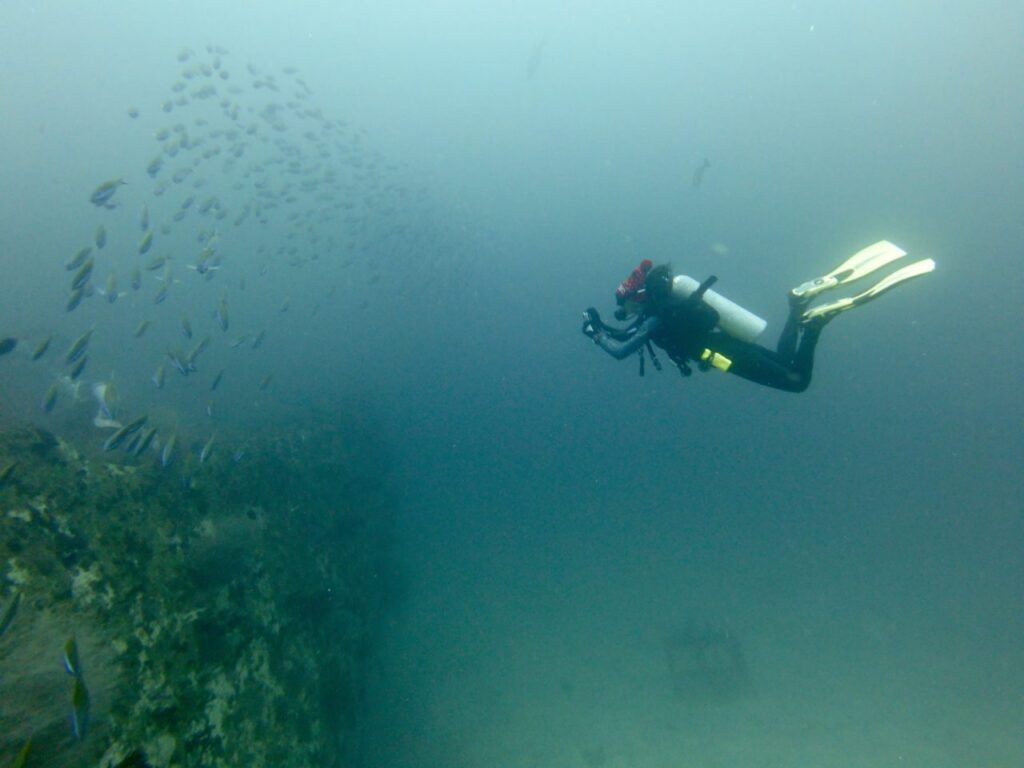

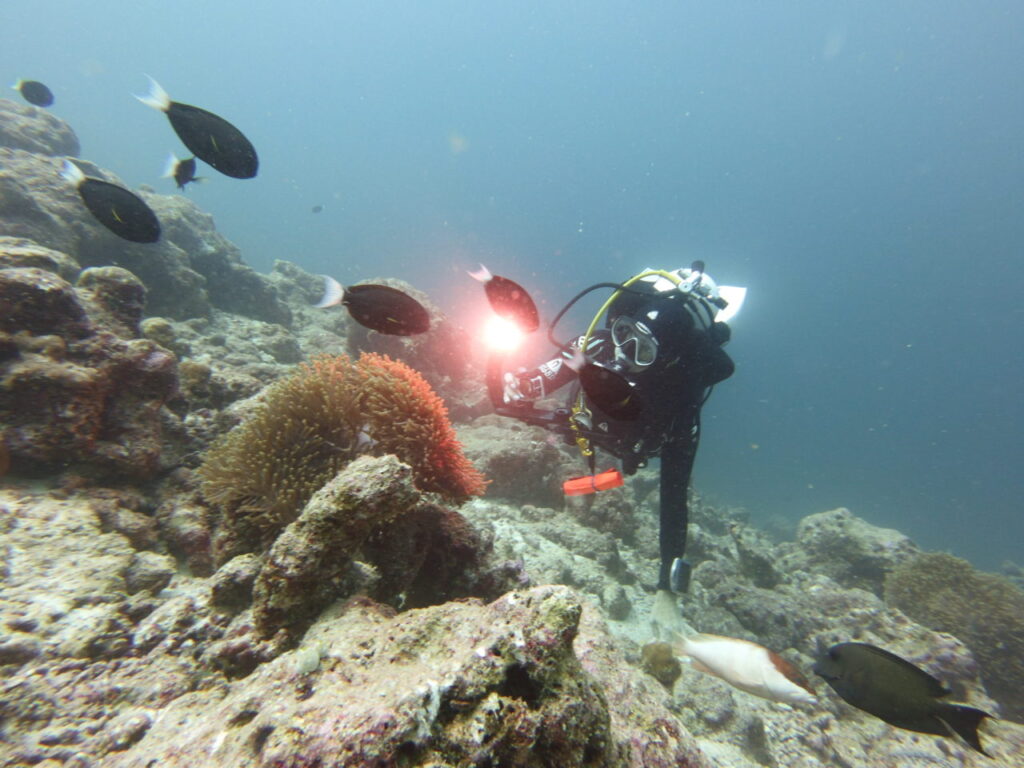

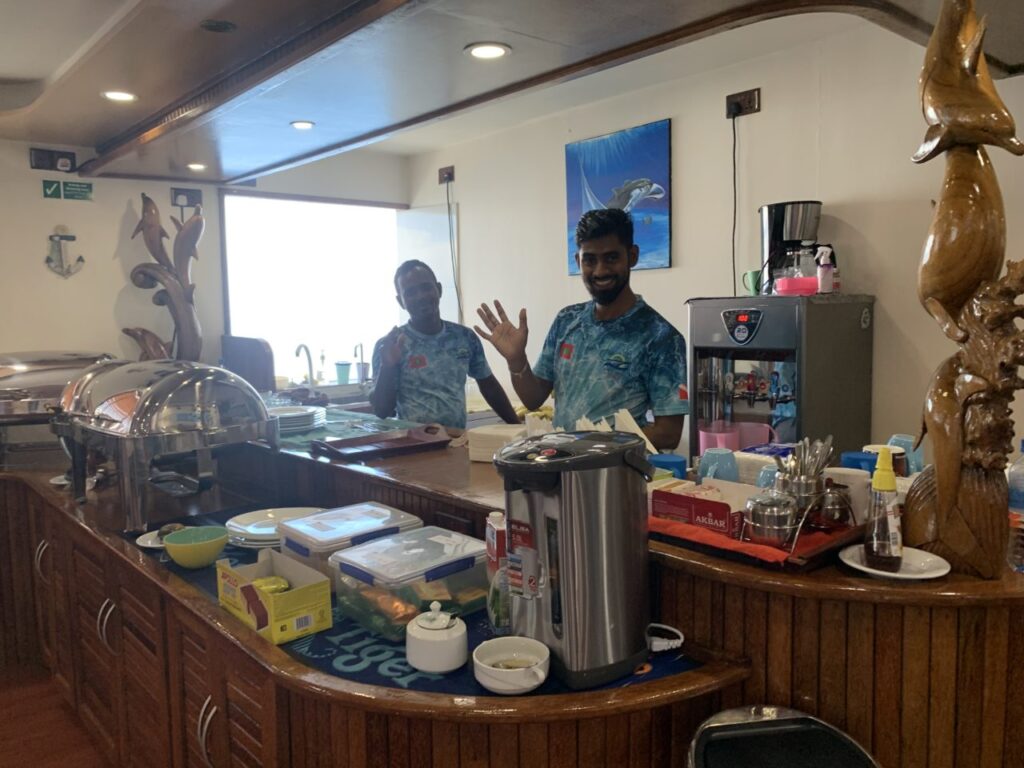
Although some of the largest Maldives liveaboards have a dive deck on the main boat, most are accompanied by a dhoni. The dhoni is a smaller boat – kinda like a skiff. Your dive gear is kept here in an allocated box next to the rest of your groups.
It’s usually a ten to fifteen minute ride to a dive site in the dhoni and during this time you’ll pass many of the tiny Maldivian islets and islands. There’s plenty of time to prepare for the dive.
Some of these species – such as manta rays, grey reef sharks, nurse sharks, turtles and stingrays; you’re almost guaranteed to see throughout the trip, often on multiple occasions.
Others – like whale sharks, tiger sharks, hammerheads and dolphins, you have a good chance of seeing at least some of, but they’re not so common.
Manta rays are one of the stars of the Maldives and it’s hard to do justice to just how mesmerising these incredible animals are to witness in real life.You’re practically guaranteed to see mantas at some point during your liveaboard trip in the Maldives.Typically they’re highest in number between May to November, but you can definitely spot them all year round!
During my Maldives liveaboard trip in December, I saw lone manta rays on four separate dives, two together on a night dive and best of all, the four playful individuals in the video above when we visited a manta cleaning station.
These highly social and intelligent beings are as gentle as they are graceful; lacking a sting they’re no threat to divers and love to perform acrobatic movements in front of people; seemingly as if deliberately putting on a show.
Regardless of what type of dive your’e going on, all dives usually last around fifty minutes or until someone in the group is low on air.
You usually all ascend to the surface together but it’s a good idea to have a surface marker buoy and know how to use it in case you have to surface alone.
It’s rarely a long wait before the dhoni comes to pick you up. Once everyone has been collected, it’s time to head back to the liveaboard where a meal awaits. Before you go to eat, I strongly recommend you use the showers at the back of the dhoni or your cabin to rinse out your ears to avoid aches and pains as the week progresses.
After that, go eat! Breakfast is eggs, pancakes, toast, spam and fruit. Lunch and dinner are Maldivian and Indian inspired so expect plenty of fish, chicken, rice, steamed vegetables and curry-like-dishes.
If you have any special dietary requirements, you’ll have already communicated these with your liveaboard before the start of the trip so they can accommodate you.
After each meal, you usually have one and a half to two hours before the next dive briefing. This is a great time to charge camera equipment, rest and soak in the views.
There’s plenty of spaces you can chill around the liveaboard -most liveaboards feature a sundeck as well as a partially shaded lounge with hammocks, beanbags and sundecks. There will also be an indoor saloon where you can relax inside and of course you’re free to head back to your cabin where a freshly made bed awaits after the first dive.
Exact duration time between dives varies depending on where the next dive site is. Sometimes there’s a long enough wait for extra activities. On cheaper liveaboards this can mean snorkeling or kayaking. This can be done for free.
On more expensive liveaboards you may be able to participate in watersports like flyboarding or jet skiing – or get a massage if there’s an onboard spa! This costs extra.
Now let’s talk about another star of the Maldives – grey reef sharks: and lots of htem!Measuring six to eight foot long, this requiem shark species is often encountered in small groups on many dives; I saw them in twos and threes on countless occasions.
However, on a couple of dives I witnessed something I’d never seen before – literally hundreds of grey reef sharks schooling together. It was a truly epic sight to behold.:
On some days, after three dives before breakfast, lunch and dinner, there are also night dives. You’ll probably be pretty beat by this point but I highly recommend making it out to these. Night dives are only carried out when staff are sure you have a good chance of seeing something good.
On our first night dive we saw feeding manta rays; which drifted through the dark water’s like cruising ghosts, often coming within less than a foot of divers.
For the second night dive, we saw countless dozens of nurse sharks; which swarmed around us much like the stingrays had during the feeding frenzy. This was as other-worldly as it was magical and it was an incredible experience unlike any other I’ve had before on a dive.
Like manta rays, nurse sharks are harmless to divers with tiny mouths and incredibly laid back attitudes. Check out the movie below to see video from the two night dives combined:
On evenings where there’s no night diving, you can kick back with a drink around the sundeck and partially shaded lounge where there’s board games and speakers.
There is a beach bbq one night, usually half way into the week. You’ll catch a ride to a nearby island where you can wander around whilst the sun sets and staff prepare food.
Then comes the bbq itself followed by traditional drumming and dancing from the staff which you’re invited to join (they make it look easy, but it’s a pretty decent cardio workout!).
Evening activities vary between liveaboards but can also include fishing, movie and games nights.
One of my favourite things to do in the evening, was sit at the back of the liveaboard and watch dolphins hunting fish – which were in turn hunting plankton that had been attracted by the boat’s lights. I even went snorkelling with them!
There’s no official bedtime – you can stay up as late as you want but you should be quiet after 10pm and bear in mind you’ll have an early start with lots of diving the next day.
The structure and schedule I’ve described comes from my own experience exploring the central Maldives region with Soleil 2
However, in terms of daily routine, you can expect something very similar to this on any Maldivian liveaboard.
Some liveaboards vary in terms of the length of trips they run – the standard length is 7 nights but some go on for a little longer or shorter.
Depending on what region of the Maldives your liveaboard is exploring, types and frequencies of experiences may vary – for example there may be more manta cleaning station dives.
But generally speaking, you can broadly apply the routine, schedule and experiences I’ve described above to any Maldives liveaboard.
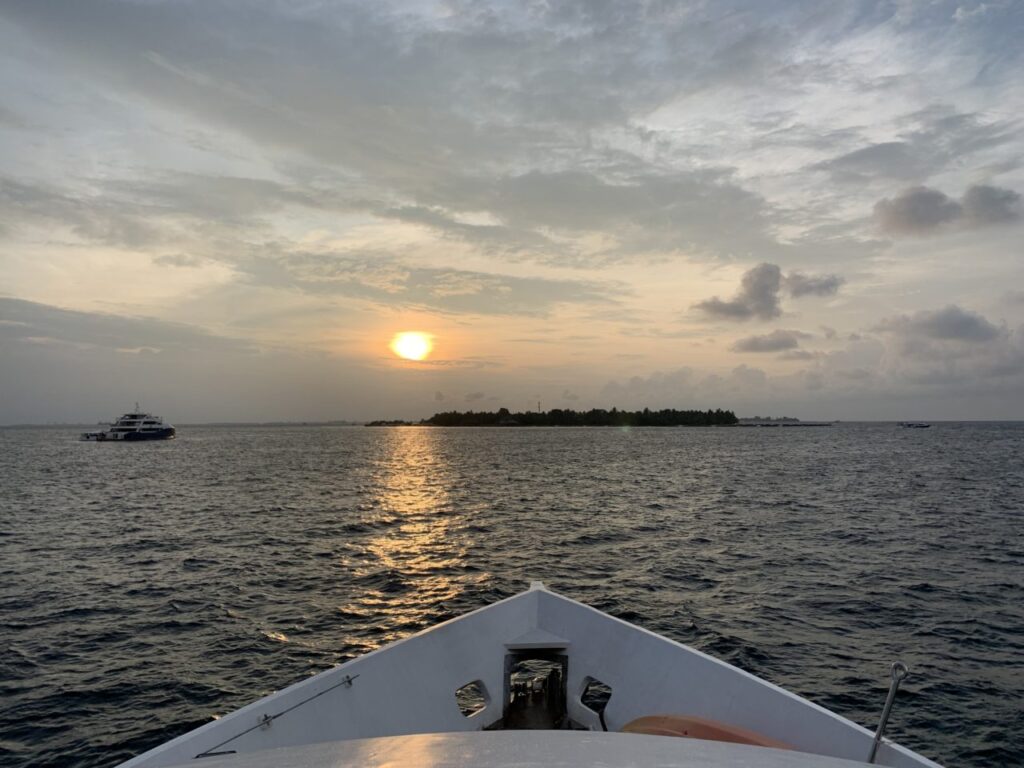
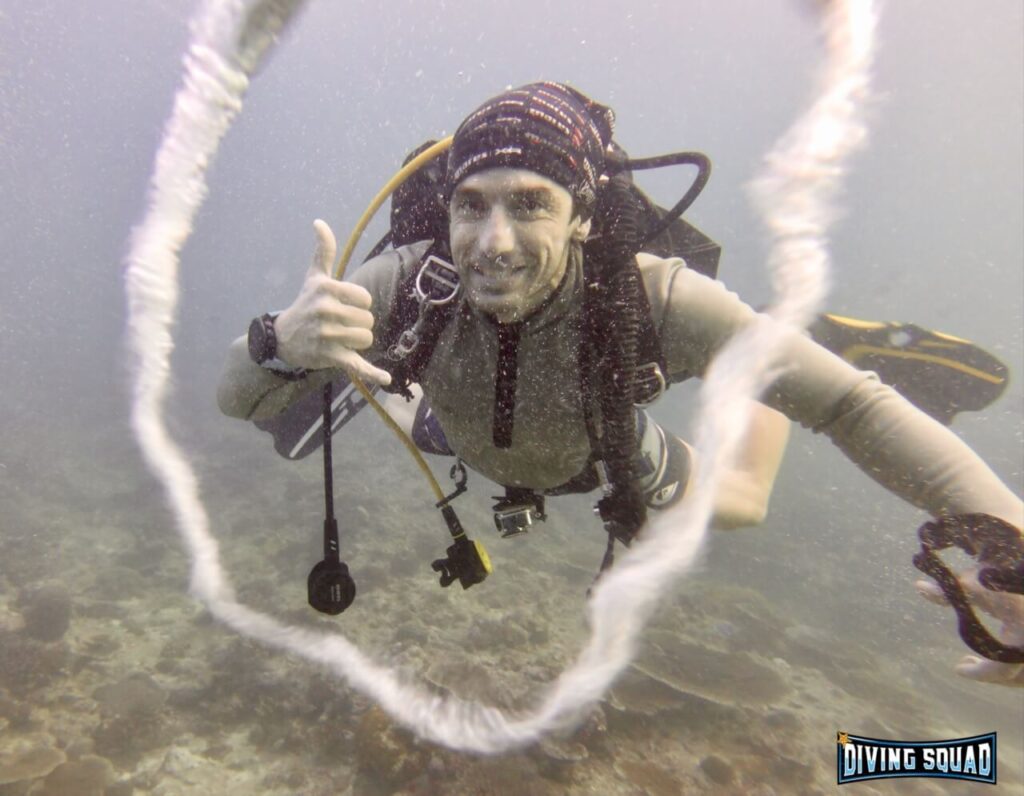
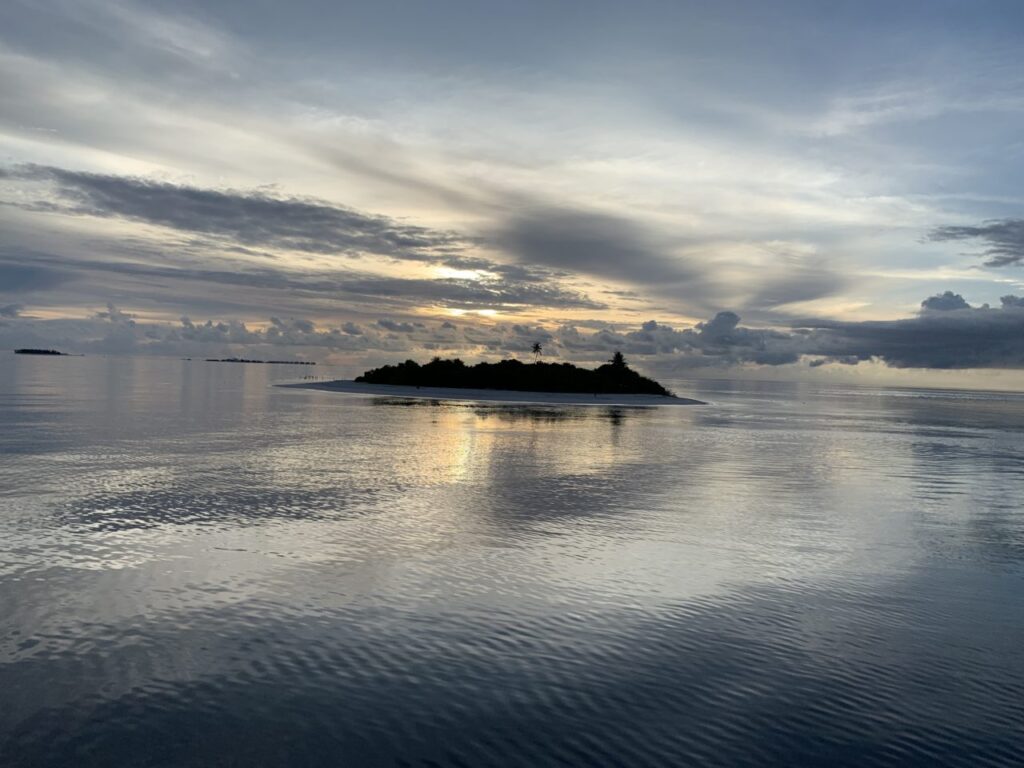
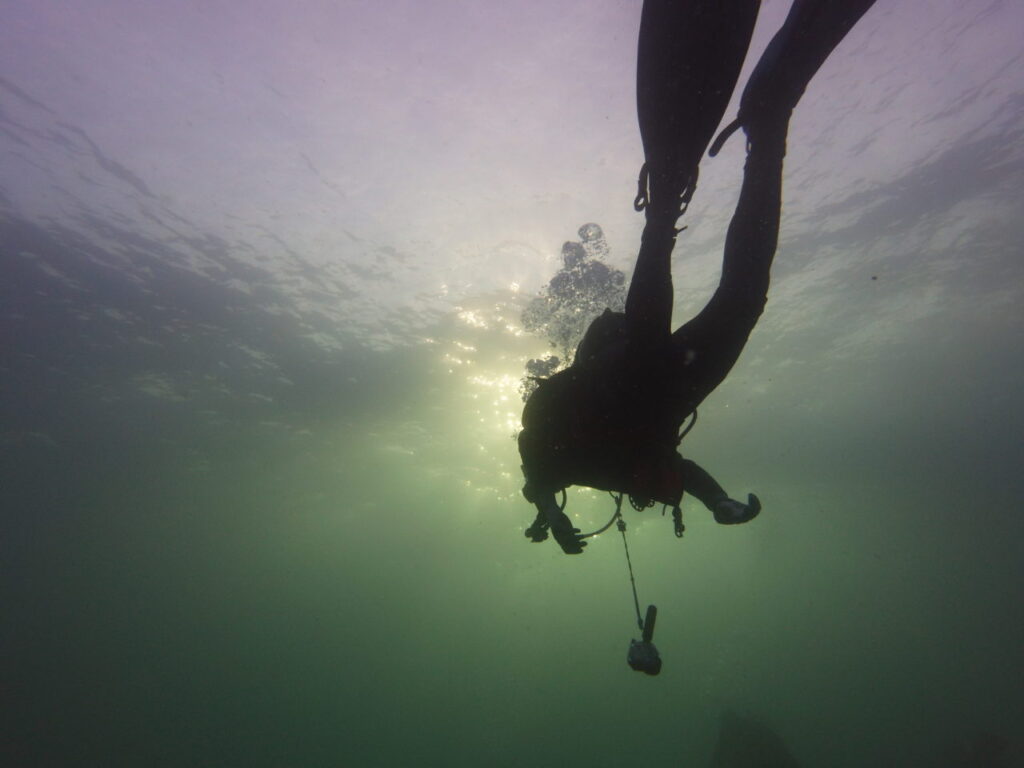
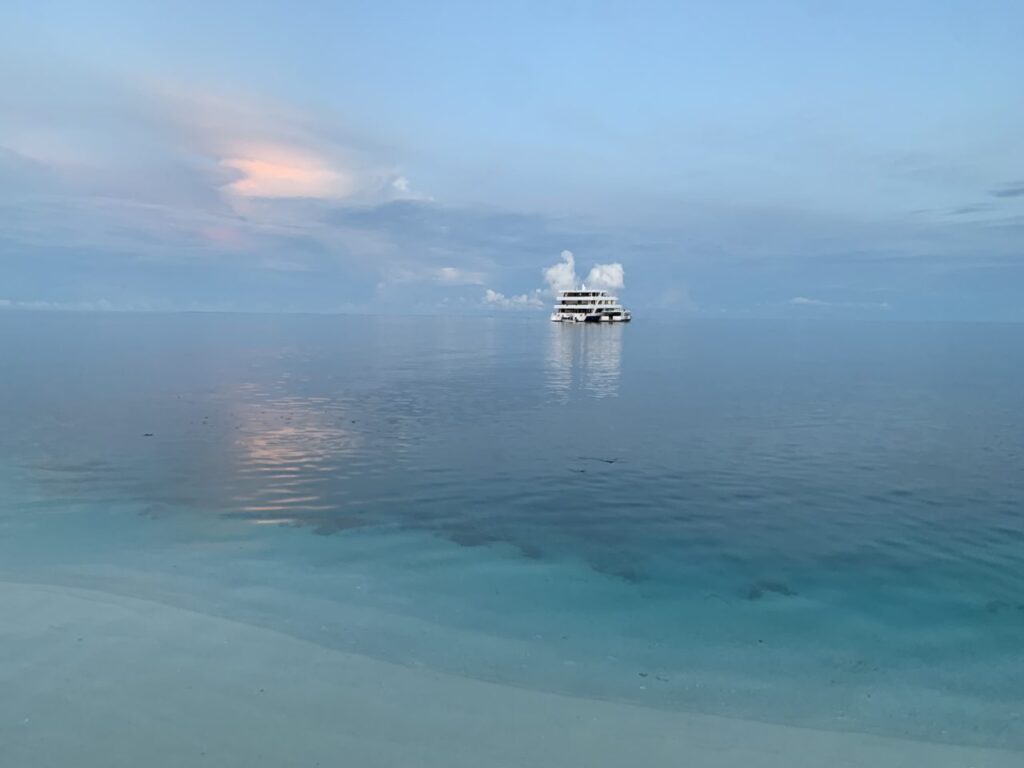
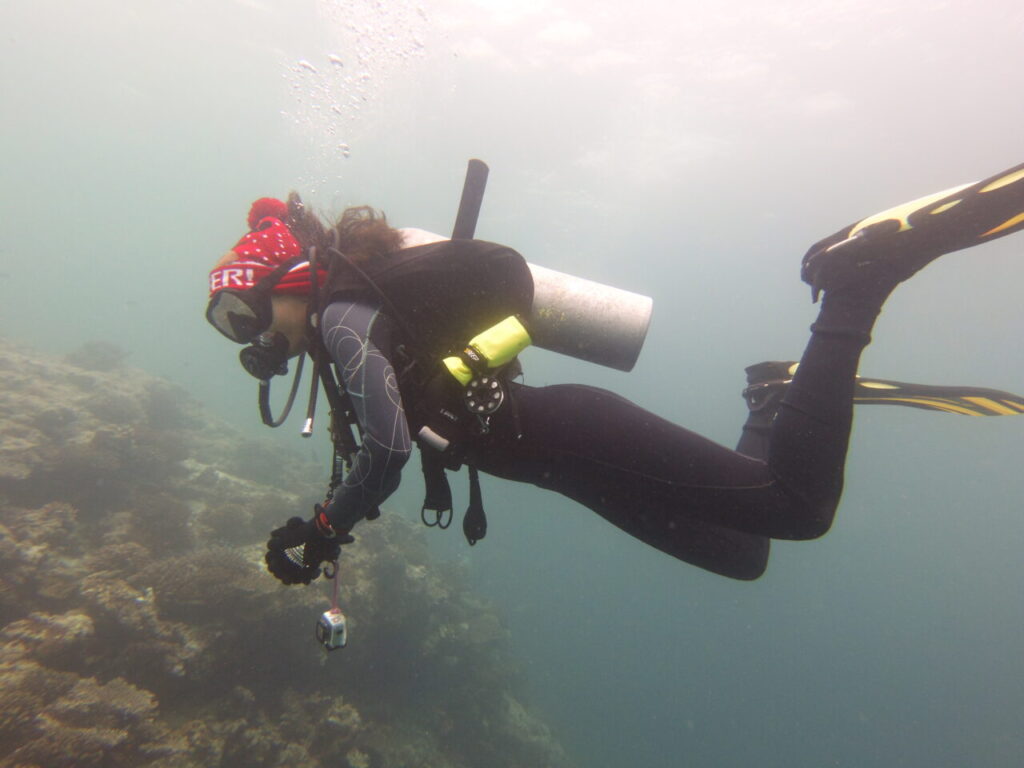
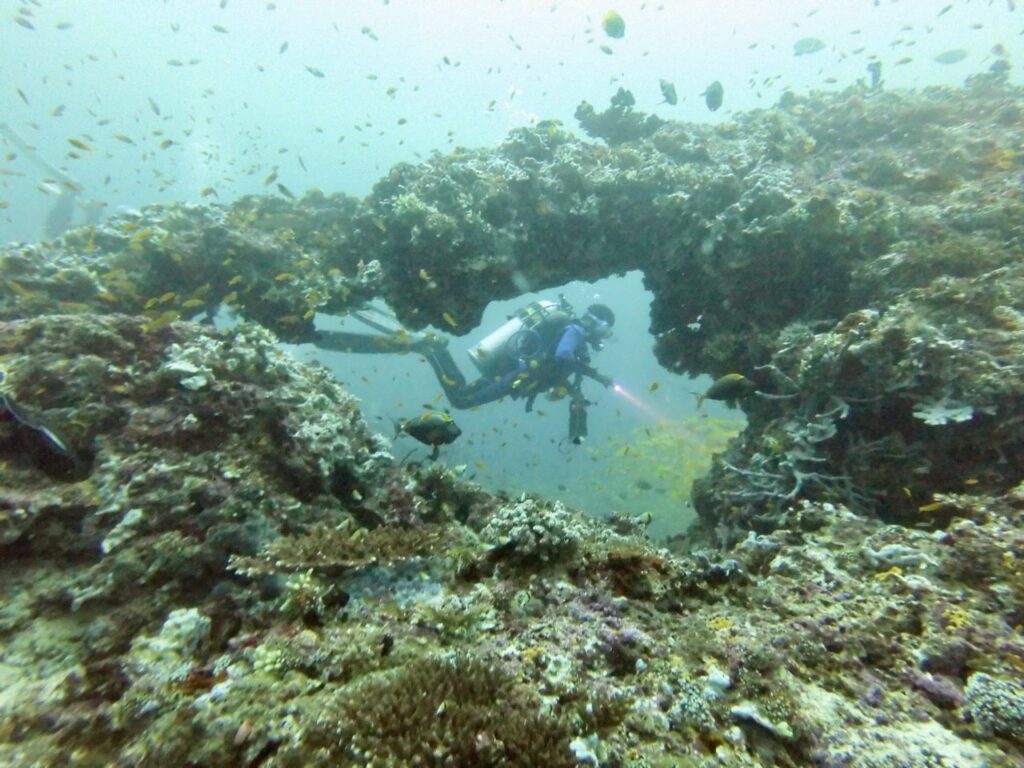
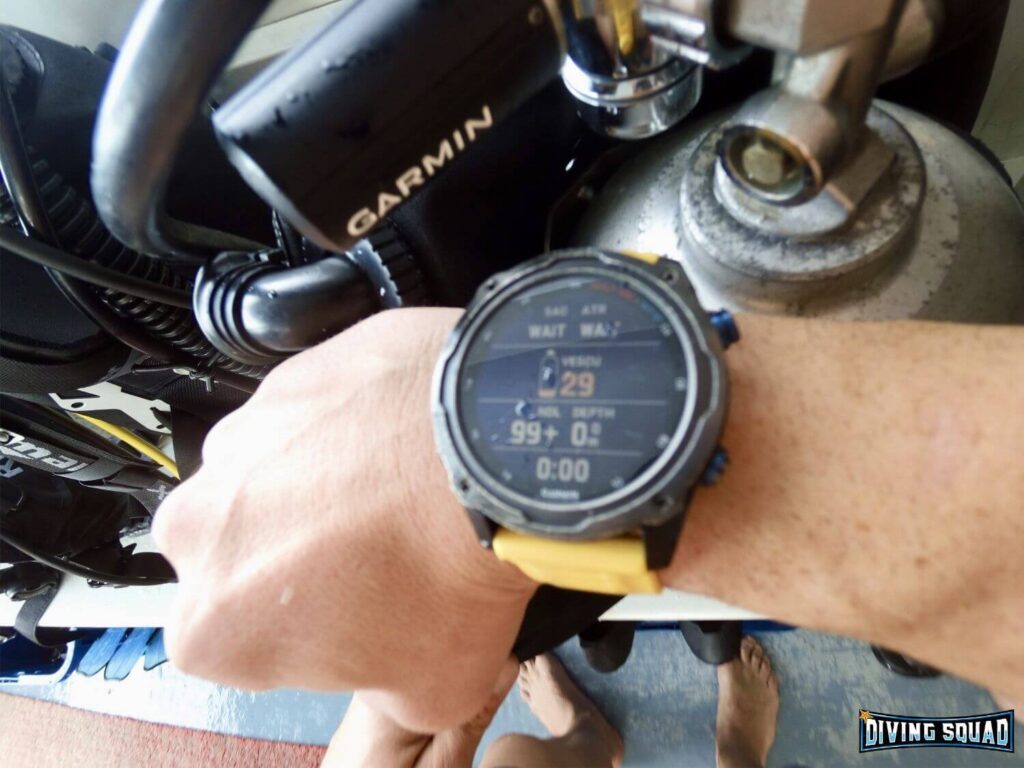
Handy Tips for your First Maldives Liveaboard
- Thoroughly rinse out your ears in between every dive to avoid aches and pains as the week progresses.
- Bring some ear drops to! You’ll be diving a lot. Divers who’ve never had painful ears may do on a liveaboard trip. I usually use these ear-drops.
- Factor in to your budget a decent tip to give the boat/kitchen-staff at the end. These guys work their arses off and can go weeks without a day off. Many are from poorer parts of the world such as Bangladesh and may go years without seeing their family who they send their money back to. There’s usually around 15 staff on the boat so $150 means they each get $10 – this should be a minimal amount.
- Ideally, take a surface marker buoy and be familiar with how to use it. Chances are you won’t have to as you ascend with your group… but you’ll want to know how just in case!
- Remember that the more off-the beaten track Maldives regions such as the deep south and far north, are better suited to more experienced divers. If you want to avoid loads of challenging dives, it’s best to go on a trip that tours the central region; which is the most famous part of the Maldives.
- It’s handy a to have a dry bag to keep your camera, phone, sun-cream, sunglasses etc in when taking them onto the dhoni.
- Get your scuba-ass scuba-insured!!This is so important. In my opinion, the best dive insurance company to go with are diveassure because they offer the highest-payouts and cover hyperbaric chamber treatment. However, you can read about all of the best dive insurance companies here.
- Get Nitrox certified. It takes one day. Every liveaboard I’ve been on, everyone and lets you stay deeper for longer. If need be, you can get your Nitrox course during the liveaboard trip.
- Bring a reef hook – this is extremely handy for drift dives in strong currents.
- Be present. If you take a camera, don’t forget to observe your surroundings with your own eyes every once in a while and not always through a lens.
Maldives Diving Regions / Itineraries
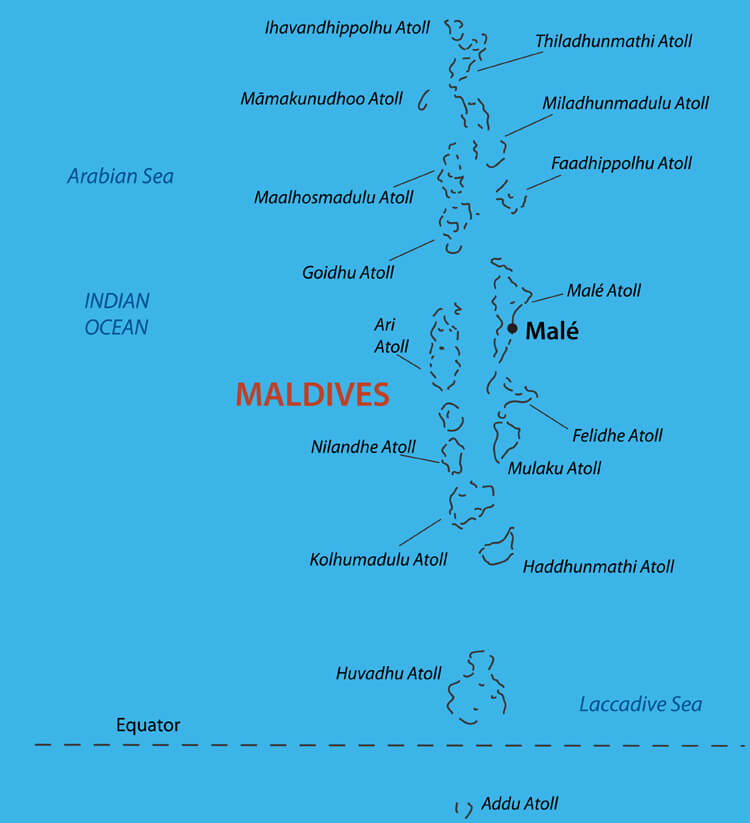
In general, the Maldives can be divided into five regions: Central the most famous, easy-to-dive and frequently explored region, North and South; which are a little more off-the-beaten track and Far North and Deep South; the hardest to reach regions.
Many Maldives liveaboards operate different itineraries / routes at different times of the year. These differing routes explore one or two of the five Maldivian regions. Virtually all Maldives liveaboards offer routes around the central region but less explore the north and south region and only a few journey to the deep south and far north.
We’ve briefly summarised the 5 diving regions of the Maldives below – but you can also get a much more detailed description of each, by checking out our main article: Scuba Diving in the Maldives
1) Central Atolls:
The most frequently visited part of the Maldives; the central region consists of the atolls of Male, Ari, Rasdhoo and Vaavu. The Maldives’ capital city and main international airport (Velana) are both situated on Male atoll, so it’s the easiest part of the island nation to reach.
There are more known scuba diving sites around Male and Ari atolls than anywhere else in the Maldives- they were the first places to be properly explored by scuba divers.
Higher levels of tourism does mean more dive boats. However, whilst you’ll see these other dive boats on the water’s surface, you’re not too likely to swim into other groups whilst actually diving. During my trip in the Central Maldives I only saw another groups of divers on two out of twenty dives.
The central region of the Maldives is the easiest to dive – currents are pretty weak meaning there are less drift dives here compared to other regions. I only experienced two drift dives out of twenty during my liveaboard trip Soleil 2
Around the central region, divers can see all of the iconic species for which the Maldives are known: whale sharks, manta rays, other sharks (including grey reef, whitetip reef, nurse, hammerhead and tiger sharks), stingrays, dolphins, turtles and scores of fish and macro critters as well as some decent coral reef.
2) South Atolls:
The first and perhaps most popular point of call for those seeking a more off the beaten track experience in the Maldives, is the southern atolls. Comprised of the atolls of Laamu, Thaa and Meemu, this area is also well known for drift dives and a varied, exciting underwater landscape.
There is a lot of big pelagic hunting action around the south Maldives with the likes of grey reef sharks, dogtooth tuna and eagle rays seen regularly hunting enormous schools of fish.
There’s also various manta ray cleaning stations and whale shark sightings as well as several sheltered lagoons where divers can see beautiful coral, turtles and colourful reef creatures such as napoleon wrasse.
Although large marine animals can be seen throughout all of the Maldives, the deep south region is the best place in the country for sheer diversity of big marine life. For example, in addition to the silver tip, white tip and grey reef sharks found in other Maldivian regions, within the deep south, scuba divers can also easily encounter many tiger sharks and thresher sharks as well as sometimes see hammerhead sharks, mola mola and black oceanic manta rays.
Comprised of Addu atoll, Fuvahmulah atoll and Huvadhu atoll, the Maldives deep south region is located very close to the equator. This means that diving conditions here remain excellent throughout the year, with great underwater visibility, calm seas and clear skies overhead.
Also, within the deep south lies the Maldives’ biggest shipwreck: the 134 meter long British loyalty which is covered in a lot of intricate hard and soft corals and home to species like batfish, frogfish and lobsters.
3) North Atolls:
Consisting of the Baa, Raa and Lhaviyani atolls, the north Maldives is less frequented by liveaboards than the southern region, so it’s the ideal place to go if you want to see as few other humans as possible!
Baa atoll is famous for Hanifaru Bay where according to some, between May and October, more manta rays and whale sharks gather than anywhere else in the Maldives – however you can only snorkel Hanifaru Bay as scuba diving there is now prohibited.
Throughout the north Maldives, there are exciting sites that you can scuba dive, including various manta cleaning stations and exciting drift dives with silver tip sharks, black tip sharks and grey sharks as well as scores of eagle rays and hawksbill turtles across dramatic underwater landscapes of canyons, walls and thilas.
The most far flung and rarely visited region of the entire Maldives, the far north atolls are Haa Alifu, Haa Dhaalu and Shaviyani. This is the final frontier of scuba discovery within the country, with new dive sites still being discovered there.
At the most far northern point lies Haa Alifu – this atoll is 300km north of Male and has some spectacular drift dives as well as being a great place to spot leopard sharks. Found here also are several manta cleaning stations and the eighty meter long Madoo shipwreck.
Haa Dhaalu has a spectacular underwater landscape with many rocky pinnacles and mighty underwater walls and cliffs covered in colourful corals. Around this atolls various dive sites, one can spot white tip reef sharks, nurse sharks and marble rays as well as lots of big pelagic fish.
Shaviyani is the most rarely visited atoll, with new dive sites still being discovered on a frequent basis. It’s a good area for seeing guitar sharks and rays!
Maldives Diving Season / When to Go
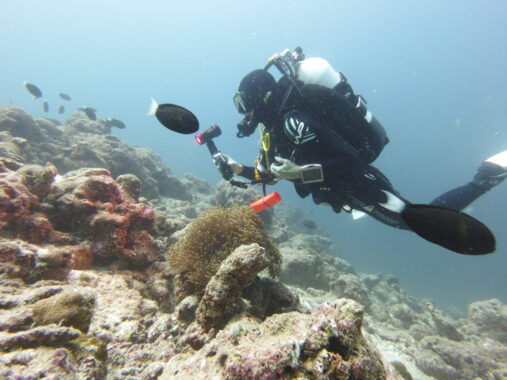
Liveaboard diving in the Maldives is possible all year! Manta rays, sharks and other large pelagic animals can be encountered at any given time. The likelihood that they will be seen is more determined by day to day factors such as high/low tide and sunrise-sunset.
That said, most parts of the Maldives (central, north, far north and south) do experience seasonal fluctuations that affect weather conditions and to some extent affect numbers of pelagic filter feeders (manta rays and whale sharks).These seasonal fluctuations also have some affect on the weather and dive conditions such as visibility and strength of currents.
January to April = DRY SEASON:
This is generally regarded as the best time to dive the Maldives. Subsequently it is high season for tourists.
A general lack of wind during this time results in clear skies, plenty of sun and calm seas. Water visibility is truly phenomenal: especially on the eastern side of the atolls, where divers can enjoy up to 35 meter visibility!
Although seas are calm on the surface, the current is strongest over this period; which results in a lot of fast paced drift diving.here are usually more manta rays and whale sharks around the western fringes of atolls during this period.
May to November = WET SEASON
Wet season is tourist low season so you may find cheaper prices and deals on liveaboards and resorts.
You can still dive during these months – in fact whilst visibility is not so good due to a higher build up of plankton, this actually you might see more manta rays and whale sharks, especially around the eastern edges of atolls.
Overhead the sky tends to be cloudier and there are often short and heavy bursts of rainfall, followed by sun. Currents are usually (but not always) a little weaker during these months.
December
This is a transitional month between the dry and wet season and subsequently can be hard to predict. It can be either more like the dry or wet season and vary by the year. It’s usually best to err on the side of caution and assume it will be more similar to a wet season month – minus the plankton build up.
Best Maldives Liveaboards – Diving Squad Debriefing
Diving Squad – at ease! We’ve finished reviewing the best Maldives liveaboards as well as going through everything else you need to know including how to book one, what to expect when you’re there and also different regions, seasons and more.
The information you’ve read today comes from first hand experiences of going on a Maldives liveaboard from various members of Diving Squad (such as Alex on Soleil 2 and Laura on Iruvai with original videos and photos by us (you can check out our youtube channel for a full list of our movies!).
We’re constantly updating our content, so you can rest assured that what you’ve read today reflects the very latest information regarding Maldives liveaboards in 2025!
Diving the Maldives is an awesome experience and there is no better way to do it than through a liveaboard. Good luck and have an amazing trip!
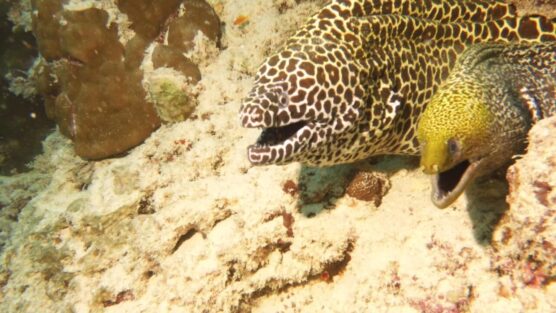
Support the Squad!
Some of the links in our content are affiliate links. This means that if you buy a product, book a liveaboard, book accommodation or purchase insurance, we earn a small commission at no extra cost to you.
It’s what helps us keep this website fresh and ultra sexy whilst funding our trips out into far flung corners of the world to gather more new content for you. Thanks!
